Manual

www.htc.com
User Manual
Please Read Before Proceeding
THE BATTERY IS NOT CHARGED WHEN YOU TAKE IT OUT OF THE BOX.
DO NOT REMOVE THE BATTERY PACK WHEN THE PHONE IS CHARGING.
YOUR WARRANTY IS INVALIDATED IF YOU DISASSEMBLE OR ATTEMPT TO
DISASSEMBLE THE PHONE.
PRIVACY RESTRICTIONS
Some countries require full disclosure of recorded telephone conversations, and
stipulate that you must inform the person with whom you are speaking that the
conversation is being recorded. Always obey the relevant laws and regulations of
your country when using the recording feature of your phone.
COPYRIGHT INFORMATION
Copyright © 2009 HTC Corporation. All Rights Reserved.
HTC, the HTC logo, HTC Innovation, ExtUSB, TouchFLO, HTC Snap, Inner Circle, and
HTC Care are trademarks and/or service marks of HTC Corporation.
Microsoft, Windows, Windows Mobile, Windows XP, Windows Vista, ActiveSync,
Windows Mobile Device Center, Internet Explorer, MSN, Hotmail, Windows Live,
Outlook, Excel, PowerPoint, Word, OneNote and Windows Media are either
registered trademarks or trademarks of Microsoft Corporation in the United States
and/or other countries.
Wi-Fi is a registered trademark of the Wireless Fidelity Alliance, Inc.
Bluetooth and the Bluetooth logo are trademarks owned by Bluetooth SIG, Inc.
microSD is a trademark of SD Card Association.
Java, J2ME and all other Java-based marks are trademarks or registered trademarks
of Sun Microsystems, Inc. in the United States and other countries.
Copyright © 2009, Adobe Systems Incorporated.
Google and Google Maps are trademarks of Google, Inc. in the United States and
other countries.
Copyright © 2009, Esmertec AG. All Rights Reserved.
Copyright © 2009, Dilithium Networks, Inc. All Rights Reserved.
ArcSoft MMS Composer™ Copyright © 2003-2009, ArcSoft, Inc. and its licensors. All
Rights Reserved. ArcSoft and the ArcSoft logo are registered trademarks of ArcSoft,
Inc. in the United States and/or other countries.
Copyright © 2009, Aplix Corporation. All Rights Reserved.
Licensed by QUALCOMM Incorporated under one or more of the following patents:
4,901,307 5,490,165 5,056,109 5,504,773 5,101,501 5,778,338
5,506,865 5,109,390 5,511,073 5,228,054 5,535,239 5,710,784
5,267,261 5,544,196 5,267,262 5,568,483 5,337,338 5,659,569
5,600,754 5,414,796 5,657,420 5,416,797
All other company, product and service names mentioned herein are trademarks,
registered trademarks or service marks of their respective owners.
HTC shall not be liable for technical or editorial errors or omissions contained herein,
nor for incidental or consequential damages resulting from furnishing this material.
The information is provided “as is” without warranty of any kind and is subject to
change without notice. HTC also reserves the right to revise the content of this
document at any time without prior notice.
No part of this document may be reproduced or transmitted in any form or by any
means, electronic or mechanical, including photocopying, recording or storing in a
retrieval system, or translated into any language in any form without prior written
permission of HTC.
Disclaimers
THE WEATHER INFORMATION, DATA AND DOCUMENTATION ARE PROVIDED “AS
IS” AND WITHOUT WARRANTY OR TECHNICAL SUPPORT OF ANY KIND FROM
HTC. TO THE MAXIMUM EXTENT PERMITTED BY APPLICABLE LAW, HTC AND ITS
AFFILIATES expressly disclaim any and all representations and warranties, express
or implied, arising by law or otherwise, regarding the Weather Information, Data,
Documentation, or any other Products and services, including without limitation
any express or implied warranty of merchantability, express or implied warranty of
fitness for a particular purpose, non-infringement, quality, accuracy, completeness,
effectiveness, reliability, usefulness, that the Weather Information, Data and/or
Documentation will be error-free, or implied warranties arising from course of
dealing or course of performance.
Without limiting the foregoing, it is further understood that HTC and its Providers
are not responsible for Your use or misuse of the Weather Information, Data and/or
Documentation or the results from such use. HTC and its Providers make no express
or implied warranties, guarantees or affirmations that weather information will
occur or has occurred as the reports, forecasts, data, or information state, represent
or depict and it shall have no responsibility or liability whatsoever to any person or
entity, parties and non-parties alike, for any inconsistency, inaccuracy, or omission
for weather or events predicted or depicted, reported, occurring or occurred.
WITHOUT LIMITING THE GENERALITY OF THE FOREGOING, YOU ACKNOWLEDGE
THAT THE WEATHER INFORMATION, DATA AND/OR DOCUMENTATION MAY INCLUDE
INACCURACIES AND YOU WILL USE COMMON SENSE AND FOLLOW STANDARD
SAFETY PRECAUTIONS IN CONNECTION WITH THE USE OF THE WEATHER
INFORMATION, DATA OR DOCUMENTATION.
Limitation of Damages
TO THE MAXIMUM EXTENT PERMITTED BY APPLICABLE LAW, IN NO EVENT SHALL
HTC OR ITS PROVIDERS BE LIABLE TO USER OR ANY THIRD PARTY FOR ANY
INDIRECT, SPECIAL, CONSEQUENTIAL, INCIDENTAL OR PUNITIVE DAMAGES OF ANY
KIND, IN CONTRACT OR TORT, INCLUDING, BUT NOT LIMITED TO, INJURY, LOSS OF
REVENUE, LOSS OF GOODWILL, LOSS OF BUSINESS OPPORTUNITY, LOSS OF DATA,
AND/OR LOSS OF PROFITS ARISING OUT OF, OR RELATED TO, IN ANY MANNER,
OR THE DELIVERY, PERFORMANCE OR NONPERFORMANCE OF OBLIGATIONS, OR
USE OF THE WEATHER INFORMATION, DATA OR DOCUMENTATION HEREUNDER
REGARDLESS OF THE FORESEEABILITY THEREOF.
Important Health Information and Safety Precautions
When using this product, the safety precautions below must be taken to avoid
possible legal liabilities and damages. Retain and follow all product safety and
operating instructions. Observe all warnings in the operating instructions on the
product.
To reduce the risk of bodily injury, electric shock, fire, and damage to the
equipment, observe the following precautions.
ELECTRICAL SAFETY
This product is intended for use when supplied with power from the designated
battery or power supply unit. Other usage may be dangerous and will invalidate
any approval given to this product.
SAFETY PRECAUTIONS FOR PROPER GROUNDING INSTALLATION
CAUTION: Connecting to improperly grounded equipment can result in an electric
shock to your device.
This product is equipped with a USB Cable for connecting with desktop or
notebook computer. Be sure your computer is properly grounded (earthed) before
connecting this product to the computer.
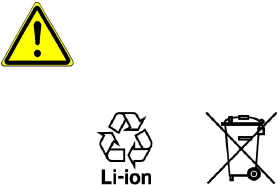
The power supply cord of a desktop or notebook computer has an equipment-
grounding conductor and a grounding plug. The plug must be plugged into an
appropriate outlet which is properly installed and grounded in accordance with all
local codes and ordinances.
SAFETY PRECAUTIONS FOR POWER SUPPLY UNIT
• Use the correct external power source
A product should be operated only from the type of power source indicated
on the electrical ratings label. If you are not sure of the type of power source
required, consult your authorized service provider or local power company.
For a product that operates from battery power or other sources, refer to the
operating instructions that are included with the product.
• Handle battery packs carefully
This product contains a Li-ion battery. There is a risk of fire and burns if the
battery pack is handled improperly. Do not attempt to open or service the
battery pack. Do not disassemble, crush, puncture, short external contacts or
circuits, dispose of in fire or water, or expose a battery pack to temperatures
higher than 60˚C (140˚F).
WARNING: Danger of explosion if battery is incorrectly replaced. To reduce risk
of fire or burns, do not disassemble, crush, puncture, short external contacts,
expose to temperature above 60° C (140° F), or dispose of in fire or water.
Replace only with specified batteries. Recycle or dispose of used batteries
according to the local regulations or reference guide supplied with your
product.
• Take extra precautions
• Keep the battery or device dry and away from water or any liquid as it may
cause a short circuit.
• Keep metal objects away so they don’t come in contact with the battery or
its connectors as it may lead to short circuit during operation.
• The phone should be only connected to products that bear the USB-IF
logo or have completed the USB-IF compliance program.
• Do not use a battery that appears damaged, deformed, or discolored, or
the one that has any rust on its casing, overheats, or emits a foul odor.
• Always keep the battery out of the reach of babies and small children, to
avoid swallowing of the battery. Consult the doctor immediately if the
battery is swallowed.
• If the battery leaks:
• Do not allow the leaking fluid to come in contact with skin or clothing.
If already in contact, flush the affected area immediately with clean
water and seek medical advice.
• Do not allow the leaking fluid to come in contact with eyes. If already
in contact, DO NOT rub; rinse with clean water immediately and seek
medical advice.
• Take extra precautions to keep a leaking battery away from fire as there
is a danger of ignition or explosion.
SAFETY PRECAUTIONS FOR DIRECT SUNLIGHT
Keep this product away from excessive moisture and extreme temperatures. Do not
leave the product or its battery inside a vehicle or in places where the temperature
may exceed 60°C (140°F), such as on a car dashboard, window sill, or behind a
glass that is exposed to direct sunlight or strong ultraviolet light for extended
periods of time. This may damage the product, overheat the battery, or pose a risk
to the vehicle.

PREVENTION OF HEARING LOSS
CAUTION: Permanent hearing loss may occur if earphones or
headphones are used at high volume for prolonged periods of time.
NOTE: For France, Earphone (listed below) for this device have been tested to comply
with the Sound Pressure Level requirement laid down in the applicable NF EN 50332-
1:2000 and/or NF EN 50332-2:2003 standards as required by French Article L. 5232-1.
• Earphone, manufactured by HTC, Model HS S200.
SAFETY IN AIRCRAFT
Due to the possible interference caused by this product to an aircraft’s navigation
system and its communications network, using this device’s phone function on
board an airplane is against the law in most countries. If you want to use this device
when on board an aircraft, remember to turn off the phone by switching to Flight
Mode.
ENVIRONMENT RESTRICTIONS
Do not use this product in gas stations, fuel depots, chemical plants or where
blasting operations are in progress, or in potentially explosive atmospheres such
as fuelling areas, fuel storehouses, below deck on boats, chemical plants, fuel or
chemical transfer or storage facilities, and areas where the air contains chemicals or
particles, such as grain, dust, or metal powders. Please be aware that sparks in such
areas could cause an explosion or fire resulting in bodily injury or even death.
EXPLOSIVE ATMOSPHERES
When in any area with a potentially explosive atmosphere or where flammable
materials exist, the product should be turned off and the user should obey all signs
and instructions. Sparks in such areas could cause an explosion or fire resulting in
bodily injury or even death. Users are advised not to use the equipment at refueling
points such as service or gas stations, and are reminded of the need to observe
restrictions on the use of radio equipment in fuel depots, chemical plants, or where
blasting operations are in progress.
Areas with a potentially explosive atmosphere are often, but not always, clearly
marked. These include fueling areas, below deck on boats, fuel or chemical transfer
or storage facilities, and areas where the air contains chemicals or particles, such as
grain, dust, or metal powders.
ROAD SAFETY
Vehicle drivers in motion are not permitted to use telephony services with
handheld devices, except in the case of emergency. In some countries, using hands-
free devices as an alternative is allowed.
SAFETY PRECAUTIONS FOR RF EXPOSURE
• Avoid using your device near metal structures (for example, the steel frame of
a building).
• Avoid using your device near strong electromagnetic sources, such as
microwave ovens, sound speakers, TV and radio.
• Use only original manufacturer-approved accessories, or accessories that do
not contain any metal.
• Use of non-original manufacturer-approved accessories may violate your
local RF exposure guidelines and should be avoided.
INTERFERENCE WITH MEDICAL EQUIPMENT FUNCTIONS
This product may cause medical equipment to malfunction. The use of this device is
forbidden in most hospitals and medical clinics.
If you use any other personal medical device, consult the manufacturer of your
device to determine if it is adequately shielded from external RF energy. Your
physician may be able to assist you in obtaining this information.
Turn the phone OFF in health care facilities when any regulations posted in
these areas instruct you to do so. Hospitals or health care facilities may be using
equipment that could be sensitive to external RF energy.
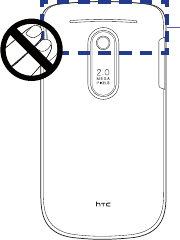
HEARING AIDS
Some digital wireless phones may interfere with some hearing aids. In the event
of such interference, you may want to consult your service provider, or call the
customer service line to discuss alternatives.
NONIONIZING RADIATION
This product should be operated in the suggested normal condition only to ensure
the radiative performance and safety of the interference. As with other mobile radio
transmitting equipment, users are advised that for satisfactory operation of the
equipment and for the safety of personnel, it is recommended that no part of the
human body be allowed to come too close to the antenna during operation of the
equipment.
Use only the supplied integral antenna. Use of unauthorized or modified antennas
may impair call quality and damage the phone, causing loss of performance and
SAR levels exceeding the recommended limits as well as result in non-compliance
with local regulatory requirements in your country.
To assure optimal phone performance
and ensure human exposure to RF energy
is within the guidelines set forth in the
relevant standards, always use your
device only in its normal-use position.
Do not touch or hold the antenna area
unnecessarily when placing or receiving a
phone call. Contact with the antenna area
may impair call quality and cause your
device to operate at a higher power level
than needed. Avoiding contact with the
antenna area when the phone is IN USE
optimizes the antenna performance and the
battery life.
Antenna
location
General Precautions
• Avoid applying excessive pressure to the device
Do not apply excessive pressure on the screen and the device to prevent
damaging them and remove the device from your pants’ pocket before sitting
down. It is also recommended that you store the device in a protective case.
Cracked display screens due to improper handling are not covered by the
warranty.
• Device getting warm after prolonged use
When using your device for prolonged periods of time, such as when you’re
talking on the phone, charging the battery or browsing the web, the device
may become warm. In most cases, this condition is normal and therefore
should not be interpreted as a problem with the device.
• Heed service markings
Except as explained elsewhere in the Operating or Service documentation,
do not service any product yourself. Service needed on components inside
these compartments should be done by an authorized service technician or
provider.
• Damage requiring service
Unplug the product from the electrical outlet and refer servicing to an
authorized service technician or provider under the following conditions:
• Liquid has been spilled or an object has fallen into the product.
• The product has been exposed to rain or water.
• The product has been dropped or damaged.
• There are noticeable signs of overheating.
• The product does not operate normally when you follow the operating
instructions.
• Avoid hot areas
The product should be placed away from heat sources such as radiators, heat
registers, stoves, or other products (including, but not limited to, amplifiers)
that produce heat.
• Avoid wet areas
Never use the product in a wet location.
• Avoid using your device after a dramatic change in temperature
When you move your device between environments with very different
temperature and/or humidity ranges, condensation may form on or within
the device. To avoid damaging the device, allow sufficient time for the
moisture to evaporate before using the device.
NOTE: When taking the device from low-temperature conditions into a warmer
environment or from high-temperature conditions into a cooler environment, allow the
device to acclimate to room temperature before turning on the power.
• Avoid pushing objects into product
Never push objects of any kind into cabinet slots or other openings in the
product. Slots and openings are provided for ventilation. These openings
must not be blocked or covered.
• Mounting Accessories
Do not use the product on an unstable table, cart, stand, tripod, or bracket.
Any mounting of the product should follow the manufacturer’s instructions,
and should use a mounting accessory recommended by the manufacturer.
• Avoid unstable mounting
Do not place the product with an unstable base.
• Use product with approved equipment
This product should be used only with personal computers and options
identified as suitable for use with your equipment.
• Adjust the volume
Turn down the volume before using headphones or other audio devices.
• Cleaning
Unplug the product from the wall outlet before cleaning. Do not use liquid
cleaners or aerosol cleaners. Use a damp cloth for cleaning, but NEVER use
water to clean the LCD screen.
Contents
Chapter 1 Getting Started
1.1 Getting to Know Your Smart Phone ................................................................21
Left panel .....................................................................................................................................21
Right panel ..................................................................................................................................21
Front panel ..................................................................................................................................22
Keyboard ......................................................................................................................................23
Back panel ...................................................................................................................................24
Accessories ..................................................................................................................................24
1.2 Installing the SIM Card, Battery, and Storage Card ....................................... 25
SIM card ........................................................................................................................................25
Storage card ................................................................................................................................27
Battery...........................................................................................................................................27
1.3 Charging the Battery ........................................................................................ 28
1.4 Starting Up ........................................................................................................29
Turning your phone on and off ...........................................................................................29
Auto configuring data connection settings ....................................................................29
1.5 Home Screen ..................................................................................................... 30
Using the HTC Home ...............................................................................................................31
Status Indicators ........................................................................................................................34
1.6 Start Menu......................................................................................................... 36
Accessing recently-opened programs ..............................................................................36
Using the Quick List .................................................................................................................36
1.7 Entering Information ....................................................................................... 37
Selecting a text input mode .................................................................................................37
Using the keyboard ..................................................................................................................38
Using Predictive Mode ............................................................................................................39
Using Numeric mode ..............................................................................................................40
Chapter 2 Using Phone Features
2.1 Using the Phone ............................................................................................... 41
2.2 Making a Call .....................................................................................................41
Making a call from the Phone screen ................................................................................41
Making a call from Contacts .................................................................................................42
Making a call from Call History ............................................................................................43
Making an emergency call ....................................................................................................43
Making an international call .................................................................................................43
2.3 Speed Dial ......................................................................................................... 44
2.4 Receiving and Ending a Call .............................................................................45
2.5 In-Call Options .................................................................................................. 46
Turning the speakerphone on and off ..............................................................................46
Enabling Call Waiting ..............................................................................................................46
Handling multiple calls ...........................................................................................................46
Setting up a conference call .................................................................................................46
Chapter 3 Synchronizing Information
3.1 About Synchronization .................................................................................... 47
3.2
Setting Up Windows Mobile® Device Center on Windows Vista® ..................... 48
Setting up synchronization in Windows Mobile Device Center ..............................48
Using Windows Mobile Device Center ..............................................................................50
3.3 Setting Up ActiveSync® on Windows® XP .......................................................51
Setting up synchronization in ActiveSync .......................................................................51
3.4 Synchronizing with Your Computer ................................................................51
Starting and stopping synchronization ............................................................................51
Selecting information to synchronize ...............................................................................52
Troubleshooting sync connection problems..................................................................53
3.5 Synchronizing via Bluetooth ........................................................................... 53
3.6 Synchronizing Music and Video ......................................................................54
Chapter 4 Managing Your Phone
4.1 Changing Basic Settings .................................................................................. 55
Personalizing the Home screen ...........................................................................................55
Setting the date, time, and alarms .....................................................................................55
Setting regional options ........................................................................................................56
Customizing sounds and notifications .............................................................................56
4.2 Managing Memory and Battery Power ........................................................... 59
Checking the phone memory ..............................................................................................59
Adjusting the power management settings ...................................................................59
Managing low battery .............................................................................................................60
4.3 Working with Files ............................................................................................ 60
Copying files to your computer ...........................................................................................60
Using File Explorer ....................................................................................................................61
4.4 Adding and Removing Programs .................................................................... 61
Using Speed Dial to open programs ..................................................................................62
4.5 Using Task Manager ......................................................................................... 63
4.6 Protecting Your Phone ..................................................................................... 64
Locking the phone and keyboard ......................................................................................64
Enabling the SIM PIN ...............................................................................................................65
Encrypting files ..........................................................................................................................65
4.7 Restarting and Resetting Your Phone ............................................................. 66
Restarting your phone ............................................................................................................66
Resetting your phone ..............................................................................................................66
Chapter 5 Organizing Information
5.1 Contacts ............................................................................................................. 67
Creating a contact ....................................................................................................................67
Editing and calling a contact ................................................................................................68
Finding a contact ......................................................................................................................68
Sharing contact information ................................................................................................69
5.2 Using Inner Circle™ ........................................................................................... 70
Creating your Inner Circle and viewing email messages ...........................................70
Managing your Inner Circle ...................................................................................................71
5.3 SIM Manager .....................................................................................................72
5.4 Calendar ............................................................................................................73
Creating an appointment ......................................................................................................73
Viewing your appointments .................................................................................................74
Sending meeting requests and appointments ..............................................................74
5.5 Tasks .................................................................................................................. 75
5.6 Voice Notes ........................................................................................................ 76
Chapter 6 Exchanging Messages
6.1 Messaging ......................................................................................................... 77
Changing the messaging account settings .....................................................................77
Copying text in messages ......................................................................................................77
Receiving messages on the Home screen .......................................................................79
6.2 Text Messages ................................................................................................... 79
Composing and sending text messages ..........................................................................79
Managing text messages .......................................................................................................80
6.3 MMS ................................................................................................................... 82
Editing MMS settings...............................................................................................................82
Creating and sending MMS messages ..............................................................................83
Viewing and replying to MMS messages .........................................................................84
6.4 Email ..................................................................................................................85
Setting Up Email Accounts ....................................................................................................85
Synchronizing Outlook email with your computer ......................................................85
Setting up an Internet email account................................................................................86
Creating and sending email messages .............................................................................88
Viewing and replying to email messages ........................................................................88
Synchronizing email messages............................................................................................90
Customizing email settings ...................................................................................................90
Chapter 7 Working with Company Email and Meeting Appointments
7.1
Synchronizing with Your Company Email Server .............................................. 91
Setting up a company email server connection ............................................................91
Starting synchronization ........................................................................................................92
7.2 Working with Company Emails ........................................................................ 92
Automatic synchronization through Direct Push .........................................................93
Scheduled synchronization ..................................................................................................93
Instant download through Fetch Mail ..............................................................................94
Searching for emails on the Exchange Server ................................................................94
Out-of-office auto-reply .........................................................................................................95
Flagging your messages .........................................................................................................95
7.3 Managing Meeting Requests ........................................................................... 96
7.4 Finding Contacts in the Company Directory .................................................. 98
Chapter 8 Getting Connected
8.1 Using Comm Manager ...................................................................................... 99
8.2 Connecting to the Internet ............................................................................100
Wi-Fi ........................................................................................................................................... 100
GPRS/3G .................................................................................................................................... 101
Dial-up ...................................................................................................................................... 102
Adjusting advanced connection settings ..................................................................... 102
8.3 Internet Explorer Mobile ................................................................................103
Browsing the Web .................................................................................................................. 103
Navigating web pages ......................................................................................................... 104
Copying web page text ....................................................................................................... 104
Adding a URL exception ...................................................................................................... 104
8.4 Using Windows Live™ .....................................................................................105
The Windows Live screen .................................................................................................... 106
Using Windows Live™ Messenger .................................................................................... 107
8.5 Internet Sharing (Using Your Phone as a Modem) .......................................108
Before you proceed ............................................................................................................... 108
Setting up the phone as a USB modem ........................................................................ 109
Setting up the phone as a Bluetooth modem ............................................................. 109
Ending the Internet connection ....................................................................................... 110
8.6 Bluetooth ........................................................................................................ 111
Bluetooth modes ................................................................................................................... 111
Bluetooth partnerships........................................................................................................ 112
Connecting a Bluetooth hands-free or stereo headset ............................................ 113
Beaming information using Bluetooth .......................................................................... 114
Setting up Bluetooth SIM Access for car kit phones ................................................. 116
Chapter 9 Navigating on the Road
9.1 Using Google™ Maps (Available by Country) ...............................................117
Opening Google Maps ......................................................................................................... 117
Searching for places of interest ........................................................................................ 118
9.2 Using Windows Live™ Search .........................................................................119
9.3 Guidelines and Preparation for Using GPS ................................................... 120
9.4 Downloading Satellite Data via QuickGPS ...................................................121
Changing the download options ..................................................................................... 122
Chapter 10 Camera and Multimedia
10.1 Taking Photos and Videos ............................................................................123
Capturing photos and video clips ................................................................................... 123
Capture modes ....................................................................................................................... 124
Camera screen icons and indicators ............................................................................... 125
Using zoom .............................................................................................................................. 126
The Review screen ................................................................................................................. 126
Customizing the advanced settings ............................................................................... 127
10.2 Using Album ................................................................................................. 131
10.3 Using Pictures & Videos ...............................................................................132
Pictures & Videos menu ....................................................................................................... 133
10.4 Using Windows Media Player Mobile .......................................................... 134
About the screens and menus .......................................................................................... 134
Playing media .......................................................................................................................... 134
Copying files to your phone .............................................................................................. 136
Troubleshooting ..................................................................................................................... 137
10.5 Using Streaming Media ................................................................................138
Chapter 11 Using Other Applications
11.1 Microsoft® Office Mobile .............................................................................. 141
11.2 Adobe® Reader® LE ....................................................................................... 142
11.3 JBlend ............................................................................................................143
Installing and running MIDlets/MIDlet suites.............................................................. 143
Managing MIDlets/MIDlet suites ..................................................................................... 144
11.4 Voice Command ............................................................................................145
Appendix
A.1 Specifications .................................................................................................147
A.2 Regulatory Notices .........................................................................................148
Index
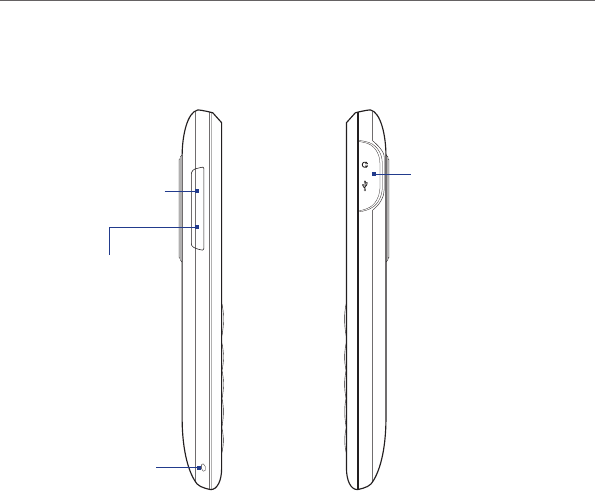
Chapter 1
Getting Started
1.1 Getting to Know Your Smart Phone
Left panel Right panel
Strap Holder
VOLUME UP
During a call or
when playing music,
press this button to
increase the volume.
VOLUME DOWN
During a call or
when playing music,
press this button to
lower the volume.
Sync Connector/
Earphone Jack
Connect the supplied
USB cable to synchronize
information or plug
in the AC adapter to
recharge the battery.
Connect the supplied
USB stereo headset for
hands-free conversation
or for listening to audio
media.
•
•
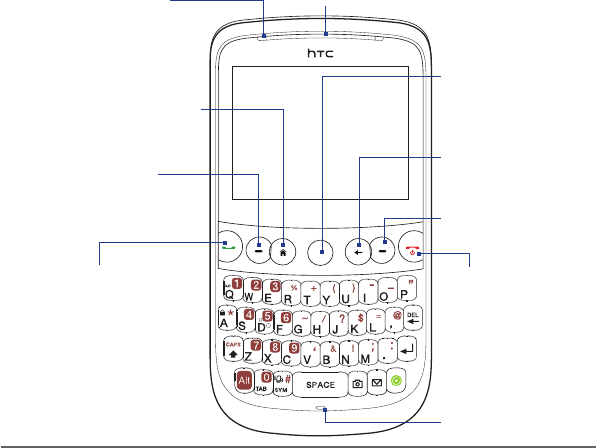
22 Getting Started
Front panel
TALK/SEND
Press to dial a number or
answer an incoming call.
During a call, press
and hold to turn the
speakerphone on and off.
When not in a call, press
and hold to activate
Voice Command.
See Chapter 11 for details.
•
•
•
HOME
Press to go to the
Home Screen.
Press and hold to display
the Quick List. See
“Quick List” for details.
•
•
BACK
Press to go to the
previous screen.
END CALL/POWER
Press to end a call or
return to the Home
screen.
Press and hold to turn
the phone on and off.
•
•
RIGHT SOFT KEY
Press to perform the
command above the
button.
LEFT SOFT KEY
Press to perform the
command above
the button.
TRACKBALL
Roll the TRACKBALL to
scroll on the screen.
Press the TRACKBALL
to click items on the
screen.
•
•
Notification LED*
See description below.
Earpiece
Listen to a phone call from here.
Microphone
* The Notification LED shows a:
Flashing green light when there are new SMS, MMS or email messages, missed calls, or reminders.
Solid green light when the phone is connected to the power adapter or a computer and the battery is
fully charged.
Solid amber light when the battery is being charged.
Flashing red light when the remaining battery level reaches below 10%.
•
•
•
•
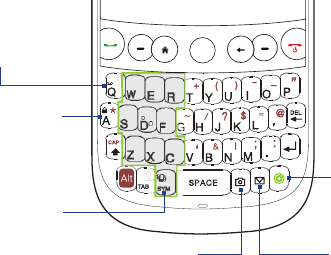
Getting Started 23
Keyboard
Enter text, numbers, and symbols using the QWERTY keyboard. See “Entering
Information” in this chapter for details.
When you are not entering information, use the special keys to perform a function
or open a program.
Inner Circle™
See “Using Inner
Circle” in Chapter 5
for details.
Vibrate
When you are not entering
text, press and hold to turn
vibrate mode on or off. Messaging
Press to open
Messaging.
Camera
Press to open
Camera.
Lock
When you are not entering
text, press and hold to
lock the keyboard and all
phone buttons.
Voicemail
When you are not entering
text, press and hold to
open your voice mail.
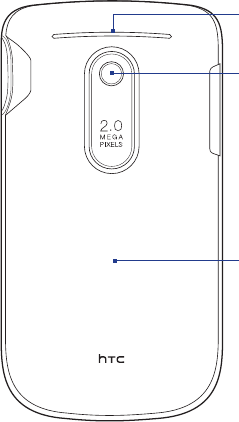
24 Getting Started
Back panel
2.0 Megapixel Camera
See “Taking Photo and
Videos with the Phone
Camera” in Chapter 10.
Speaker
Back cover
Accessories
These are the accessories that you should find in the phone package:
Battery•USB sync cable•
AC adapter•Quick Start Guide•
Wired stereo headset•Two accompanying discs•

Getting Started 25
1.2 Installing the SIM Card, Battery, and Storage Card
You need to remove the back cover before you can install the SIM card, battery,
and storage card. Also, make sure to always turn off the power before installing or
replacing the SIM card and battery.
To remove the back cover
Make sure your phone is turned off.
Hold the phone firmly with its front panel facing down.
With your thumb or finger, lift the lower part of the back cover from the
groove until it disengages from the phone.
Groove
To replace the back cover
Insert the back cover tabs to the holes at the top of the phone’s back panel.
Press the bottom part of the back cover against the phone to lock it into
place.
SIM card
The SIM card contains your phone number, service details, and phonebook/
message memory. Your phone supports both 1.8V and 3V SIM cards.
Note Some legacy SIM cards may not function with your phone. You should consult with
your service provider for a replacement SIM card. There may be fees for this service.
1.
2.
3.
1.
2.

26 Getting Started
To install the SIM card
Remove the battery if it is installed. See “To remove the battery” for details.
Locate the SIM card slot and then open the SIM card slot lock by pushing it up
towards the battery compartment.
Insert the SIM card with its gold contacts facing down and the cut-off corner
facing the battery compartment.
After sliding the SIM card completely into the slot, replace the SIM card slot
lock to keep the SIM card in place.
SIM card slot lock
2
Cut-off corner
3
4
Groove
To remove the SIM card
Remove the battery if it is installed.
Open the SIM card slot lock.
Locate the groove at the left side of the SIM card slot, and with your thumb or
finger, push the SIM card partially out of the slot.
Slide the SIM card completely out of the slot.
1.
2.
3.
4.
1.
2.
3.
4.
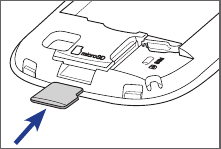
Getting Started 27
Storage card
To have additional storage for your images, videos, music, and files, you can
purchase a microSD™ card and install it into your phone.
To install the microSD card
Remove the back cover.
Insert the microSD card into the slot
with its gold contacts facing down until
it clicks into place.
Note To remove the microSD card, press it to
eject it from the slot.
1.
2.
Battery
Your phone comes with a rechargeable Lithium-ion polymer battery and is
designed to use only manufacturer-specified original batteries and accessories.
Battery performance depends on many factors, including but not limited to
your wireless service provider’s network configuration, signal strength, and the
temperature of the environment. For battery life estimates, see “Specifications” in
the Appendix.
Warning! To reduce risk of fire or burns:
• Do not attempt to open, disassemble, or service the battery pack.
• Do not crush, puncture, shorten external contacts, or dispose of in fire or water.
• Do not expose to temperatures above 60˚C (140˚F).
• Replace only with the battery pack designated for this product.
• Recycle or dispose of used battery as stipulated by local regulation.
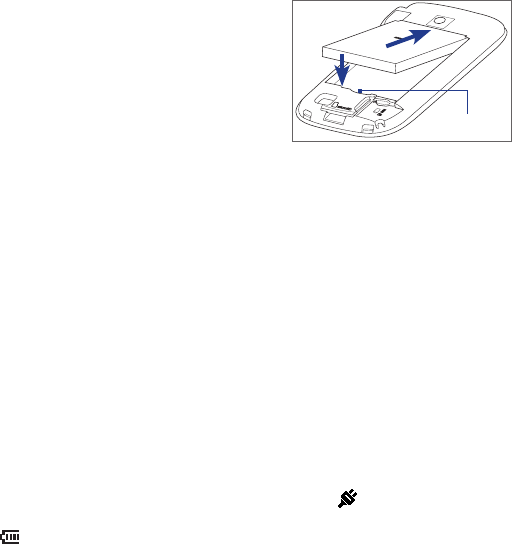
28 Getting Started
To install the battery
Remove the back cover.
Align the battery contacts with the
connectors at the upper part of the
battery compartment.
Insert the contacts side of the battery
first and then gently push the battery
into place.
Replace the back cover.
1.
2.
3.
4.
Groove
To remove the battery
Make sure your phone is turned off.
Remove the back cover.
The lower part of the battery compartment has a groove. Lift the battery from
the groove to remove it.
1.3 Charging the Battery
New batteries are shipped partially charged. Before you start using your phone, it is
recommended that you install and charge the battery. Some batteries perform best
after several full charge/discharge cycles.
Note Only the AC adapter and USB sync cable provided with your device must be used to
charge the device.
Charging is indicated by a solid amber light on the Notification LED. As the battery
is being charged while the device is on, a charging icon ( ) also appears in the
title bar of the Home screen. After the battery has been fully charged, a full battery
icon ( ) appears in the title bar of the Home screen.
1.
2.
3.
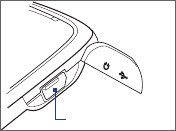
Getting Started 29
To charge the battery
Flip open the sync connector cover at
the right panel of the phone.
Insert the USB connector of the AC
adapter to the sync connector.
Plug in the AC adapter to an electrical
outlet to start charging the battery.
1.
2.
3.
Sync connector
1.4 Starting Up
After installing your SIM card and battery and charging the battery, you can now
power on and start using your phone.
Turning your phone on and off
To turn on the power
Press the END CALL/POWER button.
When you turn on your phone for the first time, the phone installs customized
settings, launches Connection Setup to auto configure your data connection
settings, and then restarts.
To turn o the power
Press and hold the END CALL/POWER button for a few seconds.
Select Yes on the confirmation screen.
Auto configuring data connection settings
The first time you power on your phone, you will see a notification message from
Connection Setup. Connection Setup automatically configures your phone’s data
connections, such as 3G/GPRS, WAP, and MMS, so that you do not need to enter the
settings manually.
1.
2.
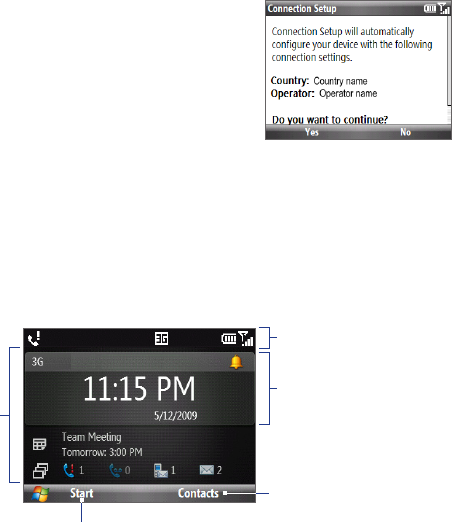
30 Getting Started
To automatically congure data connection settings
When you see the notification message from
Connection Setup, click Yes.
Note If your SIM card supports multiple network
operator profiles, a message appears with
network profile choices. Select the profile you
want to use and click OK.
Connection Setup then configures your phone’s
data connection settings. The phone restarts
after Connection Setup is finished.
1.
2.
1.5 Home Screen
The Home screen displays status indicators and HTC Home. The Home screen also
provides quick access to various applications and settings that you frequently use
on your phone.
HTC Home
See “HTC Home”
for details.
Click to display available programs
and settings on your phone.
Click to open the program,
setting, or shortcut
associated with the
selected HTC Home panel.
Title bar
Displays the status
indicators. See “Status
Indicators” for details.
Selected HTC Home
panel.
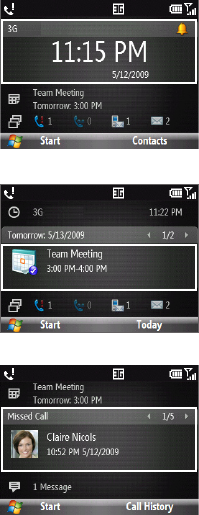
Getting Started 31
Using the HTC Home
HTC Home lets you quickly access various information, applications, and settings on
your phone. Navigate through the HTC Home panels by rolling the TRACKBALL up
or down. When a panel is selected, roll the TRACKBALL left or right to go through
the available options for that panel. Open an item by pressing the TRACKBALL.
Home
Displays the current time and date, an alarm
icon if you have set up an alarm, and the Wi-Fi
status if you have turned on Wi-Fi.
Click to open the Clock & Alarm screen where
you can adjust the time and set alarms.
Tip Pressing HOME while on any other panel
takes you back to the Home panel.
Appointments
Lets you see your upcoming appointments for
the day or set a new appointment.
If you have more than one appointment
for the day, scroll right to go through your
appointments.
Click to open the Calendar and create or
manage your appointments.
Notications
Displays your missed calls and voicemails, lets
you read snippets of unread text and media
messages, or set up a new email account.
Note For missed calls, the default icon is shown
if there is no picture associated with the
contact who called you.
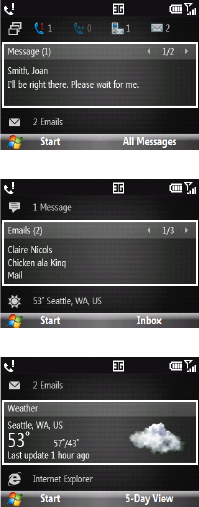
32 Getting Started
Messages
View snippets of unread messages or create
a new text or media (MMS) message. Scroll
left or right to go through your unread
messages.
Click the message to open and read the
complete message.
Emails
View snippets of your unread emails or
create a new email. Scroll left or right to go
through your unread messages.
Click the email to open and read the
complete email message.
Weather
Displays the weather information of a
selected city. Press the TRACKBALL to view
the 5-day city weather forecast.
On the Forecast screen, click Menu >
Refresh to refresh the weather information,
or click Menu > Change City to select
another city
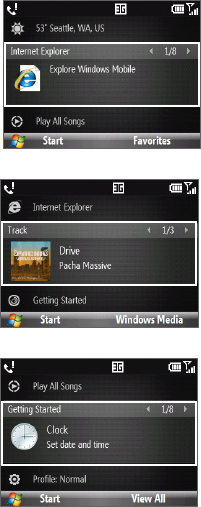
Getting Started 33
Internet Explorer
Quickly access your Internet Explorer Mobile
favorites (bookmarks). Scroll left or right to go
through your web favorites, and then press the
TRACKBALL to open Internet Explorer to your
favorite web page.
Music
Play music that is stored on the phone or on the
storage card.
Press the TRACKBALL to play or pause the song
on the screen.
Getting Started
Learn the basic features and settings of your
phone through these tutorials.
Scroll left or right to go through the available
topics, and then press the TRACKBALL to view
the selected topic.
Tip To remove the Getting Started panel from
the HTC Home, scroll right until you see
Done! Remove Getting Started, and then
press the TRACKBALL. On the Getting Started
screen, click the Add/Remove link.
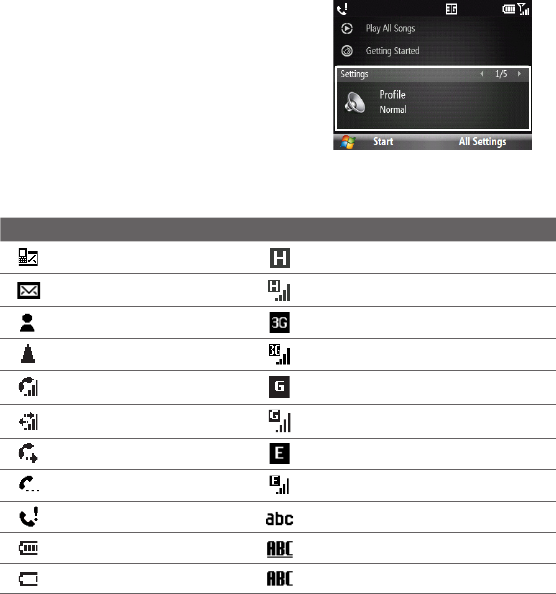
34 Getting Started
Settings
Quickly change the phone profile, ring tone,
and background image from this panel. You
can also quickly access the Comm Manager
and Task Manager programs on this panel.
Click All Settings to show all available
settings for your phone.
Status Indicators
These are the status indicators that you may see on the title bar.
Icon Description Icon Description
New text message HSDPA network available
New email message HSDPA in use
New Live Messenger message WCDMA/UMTS network available
Roaming WCDMA/UMTS in use
Voice call in progress GPRS available
Data call in progress GPRS in use
Calls forwarded EDGE available
Call on hold EDGE in use
Missed call Lowercase text input
Battery level Uppercase text input, caps lock
Low battery Uppercase text input
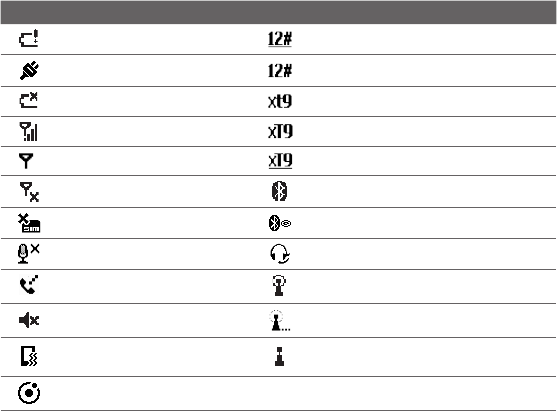
Getting Started 35
Icon Description Icon Description
Very low battery Numeric or symbol input, locked
Battery charging Numeric or symbol input
No battery or battery fault XT9 text input mode, lowercase
Signal strength XT9 text input mode, uppercase
Radio connected or no signal XT9 text input mode, caps lock
Radio off Bluetooth on
No SIM card installed Bluetooth in visible mode
Microphone muted Bluetooth headset connected
Speakerphone on Wi-Fi connected
Ringer off Connecting to wireless network
Vibrate call alert Wi-Fi enabled, but phone not connected
to a wireless network
New Inner Circle email message.
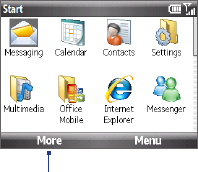
36 Getting Started
1.6 Start Menu
Your phone comes with several bundled programs that you can start using
immediately. You can also install additional programs from the included Windows
Mobile® Getting Started Disc or from other sources and install them on your phone.
Press HOME, and then click Start to see all available programs on your phone.
To view more programs, click More or roll the TRACKBALL down.
Click to show more programs.
Accessing recently-opened programs
To quickly launch recently-opened programs, you can enable the Recent Programs
screen that displays the last eight programs that you used. To enable the Recent
Programs screen, click Start > Settings > Home Screen, and then select the Show
Recent Programs check box.
Enabling the Recent Programs screen takes you directly to the Recent Programs
screen when you click Start.
Using the Quick List
The Quick List offers convenient access to common phone functions, such as
locking your phone and keypad, opening Comm Manager, and choosing a different
profile.
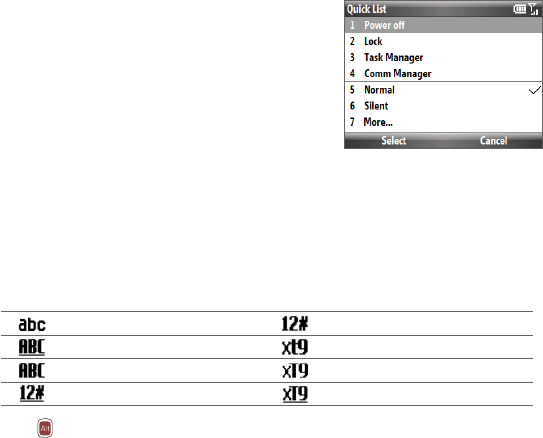
Getting Started 37
To open the Quick List
Press and hold the HOME button.
Select the desired option and click
Select.
To close the Quick List at any time, click
Cancel.
1.
2.
3.
1.7 Entering Information
Selecting a text input mode
When you open a program that allows text input, the current input mode is
indicated at the right side of the title bar. Refer to the table below.
Lowercase text input Numeric or symbol input
Uppercase text input, caps lock XT9 text input mode, lowercase
Uppercase text input
XT9 text input mode, uppercase
Numeric or symbol input, locked XT9 text input mode, caps lock
Press to toggle between uppercase, lowercase, and locked input when in any
text input mode.
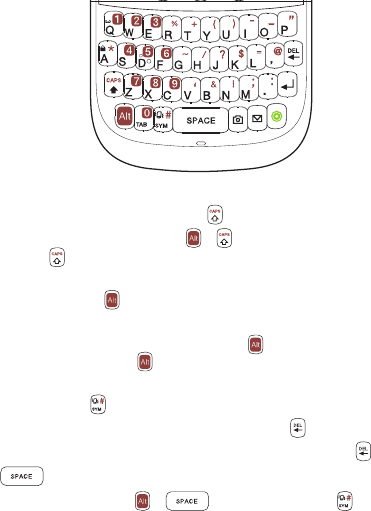
38 Getting Started
Using the keyboard
You can do the following with the QWERTY keyboard.
To type lowercase letters, press the keys using your thumbs or fingers.
To use a single uppercase letter, press and then press the corresponding key.
To use all uppercase letters, press +
. To change back to all lowercase
letters, press again.
To enter a number, symbol or punctuation that is printed at the upper-right
corner of a key, press and then press the corresponding key.
To continuously enter numbers, symbols or punctuation that are printed
at the upper-right corner of the keys, press twice and then press the
corresponding keys. Press again to exit the continuous input mode.
To open the Symbol table and insert numbers, symbols, special characters, or
punctuation, press
.
To backspace and delete a single character, press or
BACK.
To backspace and delete several characters, press and hold or
BACK
.
Press to enter a space.
While entering text, press + , or press and hold to display the text
input options menu.
•
•
•
•
•
•
•
•
•
•
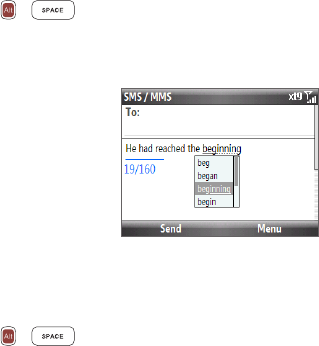
Getting Started 39
Using Predictive Mode
Predictive Mode analyzes your key presses and attempts to complete the word. It
also tries to predict your next word based on previous sentences you have entered.
To enter text in predictive mode
While entering text, press + to display the text input options menu,
and then select Predictive Text > On.
Note You can choose a different language (if available) by selecting Language on the
text input options menu, and then choosing the language you want.
2. Enter your text. While typing, a word list
will appear on the screen.
3. Scroll up or down the word list to
choose the word you want to insert,
and then press the TRACKBALL.
To add custom words to the XT9 My Words list
Save words that you often use but are not in the dictionary into the XT9 My Words
list. Words that you added to the XT9 My Words list will appear in the predicted
word list.
While entering text, press + to display the text input options menu,
and then select XT9 My Words > Add.
Note You must enable Predictive Text before you can select XT9 My Words from the
menu.
2. In the Add/Edit Word box, enter the word and click Done.
To edit or delete words in the XT9 My Words list, click Menu and then select an
option from the menu.
1.
1.

40 Getting Started
To set XT9 settings
On the text input options menu, choose XT9 Settings. In the screen, choose the
options you want and click Done.
Note You must first set Predictive Text to On before you can select XT9 Settings from the
menu.
Spell Correction. Corrects typographical errors by selecting from a list of
possible words that reflect the characters of the keys you have pressed as well
as characters of nearby keys.
Auto-Substitution. Automatically adds an apostrophe when you type
commonly contracted words (for example, “dont” automatically becomes
“don’t”).
Word Completion. Lets you select from a list of possible words based on the
keys that you pressed and on the words available in the dictionary.
Word completion by. Lets you choose which key to use to select a word from
the word completion list.
Using Numeric mode
If a text box permits a numeric entry only, such as a phone number, the input mode
automatically changes to Numeric mode. However, if you need to enter numbers
within a line of text, change to Numeric mode, and then change back to normal or
predictive mode to finish entering the text.
Use the alphanumeric keypad on the keyboard to enter numbers.
To enter numbers
While entering text, press + to display the text input options menu,
and then select 123 (Numeric mode) on the menu.
On the keypad, enter the number or numbers you want.
Change back to normal or predictive input mode by selecting either mode on
the text input options menu, and then finish entering your text.
•
•
•
•
1.
2.
3.

Chapter 2
Using Phone Features
2.1 Using the Phone
The Phone screen lets you open, call, or find a contact, and even save a new
number in Contacts. To open the Phone screen, press TALK/SEND or enter the
phone number by pressing the keys on the keypad.
Note Most SIM cards are preset with a PIN (personal identification number) that is provided
by your wireless service provider. When prompted, enter the preset PIN, and then click
Done. If you enter the wrong PIN three times, the SIM card is blocked. If this happens,
you can unblock it with the PUK (PIN Unblocking Key) obtained from your wireless
service provider.
2.2 Making a Call
You can make calls from the Phone screen, from Contacts, Speed Dial, and Call
History.
Making a call from the Phone screen
Press the TALK/SEND button.
Enter the phone number by pressing the keys on the keypad. If you press a
wrong number, press BACK.
1.
2.
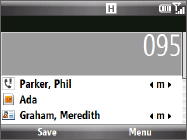
42 Using Phone Features
3. Press TALK/SEND.
Tip When you press a key on the keypad, a list
of names and numbers is displayed as your
phone searches Contacts, Call History, Speed
Dial, and your SIM card to find a matching
name or number. The next key you press
continues to narrow the search. When you
see the name of the person you want to call,
select it, and then press TALK/SEND.
Making a call from Contacts
On the Home panel, click Contacts.
Select the desired contact, and press TALK/SEND.
To choose the number to dial
By default, the mobile telephone number (m) of a contact is dialed when you make
a call from Contacts. However, if the contact has multiple contact numbers, you can
choose to dial a different phone number.
On the Home panel, click Contacts.
Select the contact.
Roll the TRACKBALL left or right. The letter representing the phone number
changes to m (mobile), w (work), or h (home).
Press TALK/SEND to dial the number.
To learn more about creating and managing Contacts on your phone,
see Chapter 5.
1.
2.
1.
2.
3.
4.
Using Phone Features 43
Making a call from Call History
On the Home screen, click Start > Call History.
Select a name or number, and press TALK/SEND.
To manage your call history
In the Call History screen:
Select a name or number and then press the TRACKBALL to view the call
information from the contact. Pressing the TRACKBALL again dials the
associated number.
Select a name or number and then click Save to save the number to Contacts.
Click Menu to select various options to customize and filter the calls you
made, received, or missed.
Making an emergency call
Enter the appropriate emergency number for your locale, and press TALK/SEND.
Tip Additional emergency numbers may be included in your SIM card. Contact your
service provider for details.
Making an international call
Press and hold the 0 (zero) key on the keyboard until the “+” symbol appears.
Enter the full phone number you want to dial, and press the TALK/SEND
button on your device. The full phone number includes the country code,
area code (without the leading zero, if any), and phone number.
To insert a pause or long pause in a dialing sequence
Some international calls or phone numbers require a pause or long pause in the
dialing sequence in order for the call to process successfully.
On the Home panel, click Contacts.
Select the contact and press the TRACKBALL to open the contact card.
Click Menu > Edit.
1.
2.
•
•
•
1.
2.
1.
2.
3.
44 Using Phone Features
Position the cursor on the phone number where you want to insert a pause.
Click Menu > Insert Pause or Insert Wait. The letter “p” (pause) or “w” (wait)
will appear in the number sequence to indicate where the pause or long
pause will occur.
Click Done.
Notes • Long pause is not available for contacts stored on the SIM card.
• When you call a number that contains a long pause, you must press TALK/SEND
again to continue dialing.
2.3 Speed Dial
You can create speed dial entries for frequently-called numbers so you can dial a
number by pressing a single key.
To create a speed dial entry
On the Home panel, click Contacts.
Select a contact and press the TRACKBALL to view the contact details.
Select the desired phone number and click Menu > Add to Speed Dial.
Specify the Name, Value, and Keypad assignment of the Speed Dial entry.
Click Done. To quit at any time during this process, click Menu > Cancel.
Note The first speed dial location is generally reserved for your voicemail. Speed Dial uses
the next available location by default. If you want to place a number in a location that
is already used, the new number replaces the existing number.
To make a call using Speed Dial
If you have assigned a speed dial (for example, the number 2 key) to a contact in
Speed Dial, you can simply press and hold the number 2 key to dial the contact’s
number.
4.
5.
6.
1.
2.
3.
4.
5.
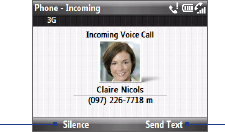
Using Phone Features 45
To delete a speed dial entry
On the Home screen, click Start > Speed Dial.
Select the desired entry and click Menu > Delete.
To retrieve a voicemail message
While on the Home screen, press and hold the number 1 key to access your voice
mailbox, and then follow the prompts to retrieve your messages.
2.4 Receiving and Ending a Call
When you receive a phone call an Incoming Voice Call message appears on the
screen and you are given the option to answer or ignore it.
To answer or ignore an incoming call
To answer the call, press the TALK/SEND button. To reject the call, press the
END CALL/POWER button.
Click to reject the call
and to send a text
message to the caller’s
mobile phone.
Click to mute the
ringing sound without
rejecting the call.
Tip To adjust the in-call volume, press the VOLUME UP/DOWN buttons on the left panel of
the phone.
To end a call
When a call is in progress, press the END CALL/POWER button to hang up.
To set advanced phone settings
You can set phone options such as reject calls with a text message and vibrate the
phone when call is connected. Click Start > Settings > Phone > Advanced and
then select the options you want.
1.
2.

46 Using Phone Features
2.5 In-Call Options
Your phone gives you various options when you are in a call.
Turning the speakerphone on and off
During a call, press and hold the TALK/SEND key to turn the speakerphone on or off.
The speakerphone icon ( ) appears in the title bar when the speakerphone is on.
WARNING! To avoid damage to your hearing, do not hold your phone against your ear
when the speakerphone is turned on.
Enabling Call Waiting
Call Waiting should be enabled and supported for you to be notified of an incoming
call when you are using the phone.
On the Home screen, click Start > Settings > Phone > Call Waiting.
Select the Provide call waiting notifications check box and click Done.
Handling multiple calls
While in a call, you are notified of another incoming call. Click Answer to take
the second call and put the first call on hold.
Do one of the following:
To end the second call and return to the rst call, press END CALL/POWER.
To switch between the two calls, press the TRACKBALL.
Setting up a conference call
Either put a call on hold (press the TRACKBALL) and dial a second number, or,
answer another incoming call during a call.
Click Menu > Conference. If the conference connection is successful, the
word “Conference” appears on the screen.
Note Not all service providers support conference calling. Contact your service provider for
details.
1.
2.
1.
2.
•
•
1.
2.

Chapter 3
Synchronizing Information
3.1 About Synchronization
You can take information from your computer wherever you go by synchronizing
them to your phone. The following types of information can be synchronized:
Microsoft Outlook® information — Office Outlook email, contacts, calendar,
tasks, and notes
Notes created using Microsoft® Office OneNote® 2007
Media — pictures, music and videos
Favorites — Website addresses you save as Favorites in Internet Explorer
Mobile on your phone or in the Mobile Favorites folder of Internet Explorer on
your computer.
Files — documents and other files
Note You can also synchronize Outlook email, contacts, calendar, and tasks on your phone
with the Exchange Server at your work. For more information about setting up your
phone to synchronize with the Exchange Server, see Chapter 7.
Before you can synchronize, you need to install and set up first the synchronization
software on your computer. For more information, see “Setting Up Windows Mobile
Device Center on Windows Vista®” and “Setting Up ActiveSync® on Windows® XP” in
this chapter.
After installing the synchronization software on your computer, connect the phone
to your computer using the USB sync cable. Upon connecting the sync cable to
your phone and your computer, the synchronization process starts automatically.
•
•
•
•
•
48 Synchronizing Information
You can also synchronize information with your computer using Bluetooth. See
“Synchronizing via Bluetooth” later in this chapter.
Notes • ActiveSync or Windows Mobile Device Center only synchronizes data on your
computer and phone. If you have installed a storage card and you want to back up
files from the storage card, use Windows Explorer on your computer to copy files
from the storage card to your computer.
• If you are sending your phone for repair or performing a hard reset, data from your
phone will be lost. It is recommended that you sync your phone to your computer
to back up your files. To back up files from the storage card to your computer, use
Windows Explorer to copy files from the storage card to the computer.
3.2
Setting Up Windows Mobile® Device Center on
Windows Vista®
Microsoft Windows Mobile® Device Center is the replacement for Microsoft®
ActiveSync® on Windows Vista®. Some versions of Windows Vista® come with
Windows Mobile Device Center already installed. If Windows Mobile Device Center
is not available on your Windows Vista®, you can install it from the Getting Started
Disc that came with your phone.
Setting up synchronization in Windows Mobile Device Center
When you connect your phone to your computer and start Windows Mobile Device
Center for the first time, you are asked to create a Wi ndows Mobile partnership
with your phone. To create a partnership:
Connect your phone to your PC. Windows Mobile Device Center configures
itself and then opens.
On the license agreement screen, click Accept.
1.
2.
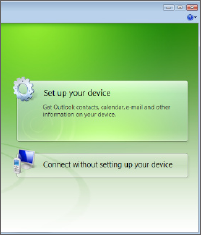
Synchronizing Information 49
On the Windows Mobile Device Home screen, click Set up your device.
Note Choose Connect without setting up your device if you only want to transfer
media files, check for updates, and explore your phone but not sync Outlook
information.
Select the information types that you want to synchronize then click Next.
Enter a name for your phone and click Set Up.
When you finish the wizard, Windows Mobile Device Center synchronizes your
phone automatically. Notice that Outlook email messages and other information
will appear on your phone after synchronization.
3.
4.
5.
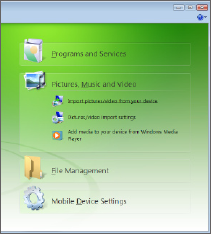
50 Synchronizing Information
Using Windows Mobile Device Center
To open Windows Mobile Device Center, click Start > All Programs >
Windows Mobile Device Center on your Windows Vista computer.
On Windows Mobile Device Center, you can do the following:
• Click Mobile Device Settings to change synchronization settings.
• When you click Pictures, Music and Video > XX new pictures/video clips
are available for import, a wizard guides you to tag and transfer photos
from your phone to the Photo Gallery on your computer.
• Click Pictures, Music and Video > Add media to your device from
Windows Media Player to synchronize music and video les using Windows
Media® Player. For more information, see “Using Windows Media® Player
Mobile” in Chapter 10.
• Click File Management > Browse the contents of your device to view
documents and les on your phone.
Note See Windows Mobile Device Center Help for more information.
Synchronizing Information 51
3.3 Setting Up ActiveSync® on Windows® XP
On a Windows® XP computer, you need to use Microsoft ActiveSync® 4.5 or later. If
you do not have this software on your computer, you can install it from the Getting
Started Disc that came with your device.
Setting up synchronization in ActiveSync
Connect your phone to your computer. The Synchronization Setup Wizard
automatically starts and guides you to create a synchronization partnership.
Click Next to proceed.
To synchronize your phone with your computer, clear the Synchronize
directly with a server running Microsoft Exchange check box, and then
click Next.
Select the information types that you want to synchronize, and then click Next.
Select or clear the Allow wireless data connections check box according to
your preference.
Click Finish.
When you finish the wizard, ActiveSync synchronizes your phone automatically.
Notice that Outlook email messages and other information will appear on your
phone after synchronization.
3.4 Synchronizing with Your Computer
Connect your phone to your PC to synchronize the information between your
phone and PC. While your phone is connected, ActiveSync (or Windows Mobile
Device Center on your PC) synchronizes every time you make a change on either
the PC or your phone.
Starting and stopping synchronization
You can manually synchronize either from your phone or computer.
1.
2.
3.
4.
5.

52 Synchronizing Information
From your phone
Click Start > ActiveSync, then click Sync. To end synchronization before it
completes, click Stop.
Tip To delete a partnership with one computer completely, disconnect your phone from
that computer first. In ActiveSync on your phone, click Menu > Options, select the
computer name, then click Menu > Delete.
From Windows Mobile Device Center
Click Start > All Programs > Windows Mobile Device Center.
Click at the lower left of the Windows Mobile Device Center.
To end synchronization before it completes, click .
From ActiveSync on your computer
When you connect your phone to your computer, ActiveSync automatically opens
on your computer and synchronizes.
To manually start synchronization, click .
To end synchronization before it completes, click .
Selecting information to synchronize
You can change the information types and the amount of information to
synchronize for each type either on your phone or your computer. Follow the steps
below to change synchronization settings on your phone.
Note Before changing synchronization settings on your phone, disconnect it from your PC.
In ActiveSync on your phone, click Menu > Options.
Select the check box for any items you want to synchronize. If you cannot
select a check box, you might have to clear the check box for the same
information type elsewhere in the list.
To change synchronization settings for an information type, for instance,
Email, select it and click Settings.
1.
2.
•
•
1.
2.
3.
Synchronizing Information 53
You can then set the download size limit, specify the time period of
information to download, and more.
Notes • Some information types such as Favorites, Files and Media cannot be selected in
ActiveSync Options on your phone. You can only select or clear these items from
your computer’s Windows Mobile Device Center or ActiveSync.
• A computer can have sync partnerships with many different Windows Mobile
powered phone, but a phone can have sync partnerships with at most two
computers. To ensure that your phone will synchronize properly with both
computers, set up the second computer using the same synchronization settings
you used on the first computer.
• Outlook email can be synchronized with only one computer.
Troubleshooting sync connection problems
In some cases, when the computer connects to the Internet or a local network, it
may disconnect the connection with your phone in favor of the Internet or network
connection.
If this happens, click Start > Settings > Connections > USB to PC, then clear the
Enable faster data Synchronization check box. This allows your computer to use a
serial USB connection with your phone.
3.5 Synchronizing via Bluetooth
You can connect and synchronize your phone with the PC using Bluetooth.
To synchronize with a computer via Bluetooth
1. Set up Windows Mobile Device Center or ActiveSync on your computer to
synchronize through Bluetooth. See the program’s Help for instructions.
2. Make sure that Bluetooth on both your phone and the computer are turned
on and set to visible mode. See “Bluetooth Modes” in Chapter 8 for details.
Note To connect and synchronize your phone with a computer via Bluetooth, your
computer must have built-in Bluetooth or installed with a Bluetooth adapter or
dongle.
54 Synchronizing Information
If this is the first time you have connected to this computer via Bluetooth,
you must first complete the Bluetooth wizard on your phone and set
up a Bluetooth partnership between your phone and the computer. For
more information about creating a Bluetooth partnership, see “Bluetooth
Partnerships” in Chapter 8.
3. On your phone, click Start > ActiveSync.
4. Click Menu > Connect via Bluetooth.
Note To conserve battery power, turn off Bluetooth when not in use.
3.6 Synchronizing Music and Video
If you want to carry your music or other digital media along with you while you
travel, set up Microsoft Windows Media Player on your computer to synchronize
music and video with your phone.
Other than selecting the media information type in ActiveSync to be synchronized,
all media synchronization settings must be set in Windows Media Player. Before
media can be synchronized, you must do the following:
Install Windows Media Player Version 11 on the PC. (Windows Media Player 11
works only in Windows XP or later versions).
Connect your phone to the PC with a USB cable.
Set up a sync partnership between the phone and Windows Media Player.
For more information about Windows Media Player on your phone, see “Windows
Media Player Mobile” in Chapter 9.
•
•
•

Chapter 4
Managing Your Phone
4.1 Changing Basic Settings
Personalizing the Home screen
The Home screen is the starting place for most of the tasks you perform on your
phone and gives you access to all the features and programs of your phone.
To customize the Home screen
On the Home screen, click Start > Settings > Home Screen.
Select from the available options and then click Done.
To set a picture as the Home screen background
On the Home screen, scroll to the Settings panel.
Scroll right until you see Background Image and then press.
Navigate to the picture you want to use and then click Done.
Setting the date, time, and alarms
To set the date and time
On the Home screen, scroll to the Home panel and then press the
TRACKBALL.
Click Date and Time and then set the Time zone, Date, and Time.
Click Done.
1.
2.
1.
2.
3.
1.
2.
3.
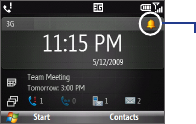
56 Managing your Phone
To set an alarm
You can set up to two alarms on your phone.
On the Home screen, scroll to the Home
panel and then press the TRACKBALL.
Click Alarm 1 or Alarm 2.
Set the alarm settings and then click
Done. When you turn on an alarm, the
Alarm icon appears on the Home panel.
1.
2.
3.
Alarm
icon
Setting regional options
Your phone comes with the regional settings that are appropriate for your locale. If
desired, you can specify the language, locale, date and time style, as well as number
and currency formatting options applicable to your region.
To change the regional settings
On the Home screen, click Start > Settings > Regional Settings.
In Language, select your preferred language.
In Locale, select the locale for the language you selected. The Locale option
automatically changes the format of the remaining options (such as date,
time, and currency) according to the locale you specify.
Click Done.
Customizing sounds and notifications
You can choose how to be notified for incoming calls, reminders, new messages,
alarms, and more.
To set the ring tone for incoming calls
On the Home screen, scroll down to the Settings panel.
Scroll right until you see Ringtone and then press the TRACKBALL.
On the Sounds screen, select a ringtone in Ring tone and then click Done.
1.
2.
3.
4.
1.
2.
3.

Managing your Phone 57
If you select Vibrate, the sound mutes and the phone will vibrate when you receive
a call. The Vibrate icon ( )
appears in the title bar. Selecting None in the Ring tone
list mutes the phone.
To change the phone prole
A profile is a group of settings that determine how your phone will alert you during
an event such as incoming calls and notifications.
On the Home screen, scroll to the Settings panel.
Navigate to the Profile option, and then press the TRACKBALL.
Select the profile you want to use and then click Done.
Tip To quickly change the profile, press and hold the HOME button to display the Quick
List, and choose a profile from the lower half of the screen.
To edit a phone prole
On the Home screen, scroll to the Settings panel.
Navigate to Profile, and then press the TRACKBALL.
Select the profile you want to edit, and then click Menu > Edit.
Modify the settings and click Done.
Tip • To revert to the default profile settings, click Menu > Reset to default.
• To cancel without saving the changes, click Cancel.
To specify the sound for an event
On the Home panel, click Start > Settings > Sounds.
For each event, select the desired sound. Select None if you do not want to
hear an event sound. Note that the sound plays when selected. To hear the
sound again, select Menu > Play.
Click Done.
1.
2.
3.
1.
2.
3.
4.
1.
2.
3.
58 Managing your Phone
To set the keyboard sound
On the Home screen, click Start > Settings > Sounds.
In Keypad control, select a sound. Select None if you do not want to hear a
sound when you press a key.
Click Done.
To copy a sound to your phone
You can use a .wav, .mid, .wma, or .mp3 audio file on your phone as a ring tone,
notification, or reminder.
Connect the phone to your PC using the USB sync cable.
On your PC, copy the sound file you want.
Explore the phone’s contents:
In Windows Mobile Device Center, click File Management > Browse the
contents of your device.
In ActiveSync on your PC, click Explore and double-click My Windows
Mobile-Based Device.
4. Navigate to your phone’s Application Data > Sounds folder and then paste
the audio le.
1.
2.
3.
1.
2.
3.
•
•
Managing your Phone 59
4.2 Managing Memory and Battery Power
Checking the phone memory
To see how much phone memory is available
On the Home screen, click Start > Settings > About.
Scroll down to check the Available Memory and the Available Storage on
your phone.
Adjusting the power management settings
You can use Power Management to check the battery, and configure settings that
prolong battery life.
On the Home screen, click Start > Settings > Power > Power Management.
Main battery indicates the remaining battery life.
To optimize battery power, you can adjust the following settings:
In Backlight brightness, lower the backlight brightness for maximum
battery life.
In Backlight time out on battery/AC and Display time out on battery/
AC, set the time when the backlight and display will turn o when the
phone is not in use.
In Adjust keypad backlight by light sensor, select whether to enable or
disable the light sensor to sense dark conditions and to activate a backlight
under the keyboard.
In When device is turned on, do not charge the battery when
connected to the PC, select O if you want to charge the phone battery
every time the phone is connected to the computer via USB.
Click Done.
1.
2.
1.
2.
•
•
•
•
3.
60 Managing your Phone
Managing low battery
When the low-battery warning appears, do the following:
1. Immediately save the le you are working on.
2. Synchronize with your PC or use the AC adapter to charge the battery.
3. Turn o your phone. Turn it back on only when you need to use it.
4.3 Working with Files
You can copy files between your phone and computer, or copy files to a storage
card installed on your phone. You can also efficiently manage your files and folders
using File Explorer.
Copying files to your computer
Connect your phone to your PC.
Do any of the following:
In Windows Mobile Device Center, click File Management >
Browse the contents of your device.
In ActiveSync on your PC, click Explore. This opens the Mobile Device
folder for your phone.
3. Browse your phone for les that you want to copy to your PC.
4. Select and copy the les [Ctrl + C] and then paste them [Ctrl+V] to the
destination folder in the PC.
Copying a file results in separate versions of a file on your phone and PC. Changes
made to one file will not affect the other since the files are not synchronized.
1.
2.
•
•
Managing your Phone 61
Using File Explorer
File Explorer provides many easy-to-use features for file and folder management.
File Explorer lets you browse and manage the contents of your phone.
To start File Explorer
Click Start > Accessories > File Explorer.
The root folder on the phone is named My Device, and contains the
following folders: My Documents, Program Files, Windows, and more.
Click a folder or file to open it.
To return to an upper level folder, click Up and select the folder.
To copy les to a storage card
Make sure that the storage card is properly installed on your phone.
See Chapter 1 for details.
On the File Explorer screen, navigate to the appropriate folder.
Select the file you want to copy, and then click Menu > Edit > Copy.
Click Up until you get to the root folder (My Device) and then click Storage
Card in the list.
Click Menu > Edit > Paste.
4.4 Adding and Removing Programs
Before you purchase additional programs for your phone, make sure that they are
compatible for Windows Mobile® 6.1 Standard operating system. Also, before you
launch the program installer, check first whether the installer can directly run on
Windows Mobile or needs to be run on a computer.
To install a program directly on your phone
1. If the installer is a .cab le, directly download or copy it to your phone.
2. On your phone, open File Explorer and navigate to the installer le.
1.
2.
3.
1.
2.
3.
4.
5.
62 Managing your Phone
3. Click the le to launch the installer.
4. Choose whether to install the program into the main memory or your storage
card, if you have the storage card inserted on your phone.
5. Wait for the installation to complete.
Note You may be prompted to restart your phone after installation is completed.
To install a program from your computer
1. If the installer is an .exe le such as Setup.exe, most likely, the installer needs
to be run on a computer. Download or copy it to your computer.
2. Connect your phone to your computer using the USB cable, and then double-
click the installer le on your computer to launch the installer.
3. Follow the on-screen instructions on your computer and your phone to
complete the installation.
To remove a program
On the Home screen, click Start > Settings > Remove Programs.
Scroll to the program to remove and then click Menu > Remove.
Using Speed Dial to open programs
You can create speed dial entries for frequently-used programs so you can open a
program simply by pressing a single key.
To create a speed dial entry for a program
On the Home screen, click Start > All Programs and then highlight the
program you want to assign to a speed dial key.
Click Menu > Add Speed Dial.
Specify the Name and Keypad assignment of the Speed Dial entry.
Click Done.
1.
2.
1.
2.
3.
4.
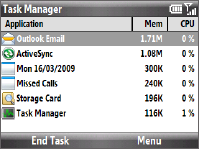
Managing your Phone 63
To open a program using Speed Dial
If you have assigned a speed dial (for example, number 3) to a program in Speed
Dial, you can simply press and hold the number 3 key on the phone keypad to open
the program.
To delete a speed dial entry
On the Home screen, click Start > Speed Dial.
Select the entry you want to delete and click Menu > Delete.
4.5 Using Task Manager
Task Manager allows you to view or stop programs that are currently running on
your phone.
To stop a running program
On the Home screen, click Start >
Accessories > Task Manager.
On the Task Manger screen, select
a program on the list and then click
End Task.
Tip To stop all running programs, click
Menu > End All Tasks.
1.
2.
Click Menu to open a menu where you can change the view, sorting order, refresh
the screen, and more.
1.
2.

64 Managing your Phone
4.6 Protecting Your Phone
You can protect your phone from unauthorized use and accidental keypresses
by locking the phone and keyboard or by requiring a PIN (personal identification
number) in order to make calls.
Locking the phone and keyboard
To enable the phone lock
On the Home screen, click Start > Settings > Security > Device lock.
Select Prompt if device unused for, and then select the amount of time for
the phone to be inactive before automatically locking.
Select the Password type, then enter and confirm your password.
Click Done.
Note • Once you configure the phone lock settings, you can enable the phone lock from
the Quick List directly without configuring the settings again.
• To disable the phone lock, click Unlock and then enter the password you have set
to unlock your phone.
To lock the keyboard
Locking the keyboard prevents accidental keypresses when the phone is in your
bag or pocket.
While on the Home screen, press and hold . You can also quickly lock the
keyboard by pressing and holding the HOME button to display the Quick List, and
then selecting Lock on the menu.
Notes • You can still receive calls and make emergency calls when the keypad and
keyboard are locked.
• To unlock the keyboard, click Unlock (LEFT SOFT KEY) and then press .
1.
2.
3.
4.
Managing your Phone 65
Enabling the SIM PIN
On the Home screen, click Start > Settings > Security > Enable SIM PIN.
Enter your PIN, and click Done.
Note To disable the SIM PIN, click Start > Settings > Security > Disable SIM PIN from the
Home screen. When prompted, enter your PIN, and click Done.
To change the SIM PIN
Be sure to remember your SIM PIN. When the SIM PIN is enabled, you must provide
the same PIN to unlock the phone.
Click Start > Settings > Security > Change SIM PIN.
In Old PIN, enter the current PIN.
Enter and confirm the new PIN, and click Done.
Encrypting files
You can set your phone to encrypt files as they are saved on the storage card.
Click Start > Settings > Security > Encryption and select Encrypt files placed on
storage cards.
Notes • Encrypted files can only be read on the phone that encrypted them.
• Encrypted files are opened just like other files, provided you are using the phone
that encrypted them. There is no separate step for you to take to read these files.
Important If Encrypt files placed on storage cards is enabled, backup all files from the
storage card before using Clear Storage or updating the operating system.
Otherwise you will no longer be able to access the encrypted files on the storage
card. Use ActiveSync or Windows Mobile Device Center to transfer files between
your storage card and computer. After the procedure, copy your files back to the
storage card.
1.
2.
1.
2.
3.
66 Managing your Phone
4.7 Restarting and Resetting Your Phone
Restarting your phone
Restart your phone when a program is not performing properly or the phone is not
responding to keypresses.
Warning! If the phone is restarted while a program is running, any unsaved work will be
lost.
To restart your phone
Remove the battery. See Chapter 1 for details.
After three seconds, replace the battery and turn on your phone.
Resetting your phone
Resetting your phone will remove all the data from its memory and restore the
phone back to the factory default settings.
Note If Encrypt files placed on storage cards is or was enabled before, then backup all
files from the storage card BEFORE using Clear Storage or updating the ROM system
software. Otherwise you will no longer be able to access the encrypted files on
the storage card. Use ActiveSync or Windows Mobile Device Center to transfer files
between your storage card and computer. After the procedure, copy your files back to
the storage card.
Warning! Because all your data will be deleted, it is recommended that you back up your
data first before resetting your phone.
To reset your phone
Click Start > Accessories > Clear Storage.
Follow the on-screen instructions to reset the phone.
The phone will restart and will display the Home screen.
1.
2.
1.
2.

Chapter 5
Organizing Information
5.1 Contacts
Contacts is your address book and information storage for the people and
businesses you communicate with. If you use Outlook on your PC, you can
synchronize contacts between your phone and PC.
Creating a contact
On the Home panel, click Contacts > New > Outlook Contact.
Note To create a new contact on your SIM card, select SIM Contact. You can also use
SIM Manager to add contacts to your SIM card. For more information about SIM
Manager, see “SIM Manager” in this chapter.
Enter the contact details in the fields provided.
To easily identify the caller, you can assign a custom ring tone to each
Outlook contact. To assign a custom ring tone, scroll down to Custom ring
tone, and select the desired ring tone.
To assign a picture to a contact, scroll down to Picture, click Select a picture
and choose the picture you want.
Click Done.
Tip If someone who is not in your list of contacts calls you, you can quickly create a
contact from Call History by clicking Menu > Save to Contacts.
1.
2.
3.
4.
5.
68 Organizing Information
Editing and calling a contact
To view and edit a contact information
On the Home panel, click Contacts.
Select the contact whose information you want to view or edit and click
Menu > Edit.
When finished making changes, click Done.
To call a contact from the contacts list
On the Home panel, click Contacts.
Select the contact to call and press TALK/SEND. The contact’s default phone
number is dialed.
Tip To call a phone number other than the default, click the contact, scroll to the number
you want to dial, and press TALK/SEND.
Finding a contact
To nd a contact
On the Home panel, click Contacts.
Do one of the following:
Begin entering a name or phone number of the contact until the contact
is displayed. When you press a key, such as S, you nd rst and last names
that begin with S. The next key you press continues to narrow the search.
If you have assigned categories (e.g. Business) to your Outlook contacts,
you can lter the contacts list by categories. In the contacts list, click
Menu > Filter and then click a category. To show all contacts again, select
All Contacts.
If you have entered information under Company for your Outlook
contacts on your phone, you can quickly locate the contacts that work for
a specic company. In the contacts list, click Menu > View By > Company.
Click the company to see the contacts who work there.
Note To return to the contacts list in Name view, click Menu > View By > Name.
1.
2.
3.
1.
2.
1.
2.
•
•
•
Organizing Information 69
Sharing contact information
To send contact information via Bluetooth
On the Home panel, click Contacts and then select the contact whose
information you want to beam.
Click Menu > Send Contact > Beam.
Select the device where you want to beam the contact details to and click
Beam.
Note Before you can beam, make sure Bluetooth is turned on and set to Visible mode on
your phone and the target mobile device. For more information, see “Bluetooth” in
Chapter 8.
To send contact information via a text message
On the Home panel, click Contacts and then select the contact whose
information you want to send.
Click Menu > Send Contact > SMS/MMS. Select the contact information that
you want to send and click Done.
In the new text message, enter the mobile phone number of the person you
want to send the contact information to and click Send.
To send contact information via MMS
On the Home panel, click Contacts.
Select a contact, then click Menu > Send as vCard.
Enter the recipient in the To field of the MMS message, and then click Send.
1.
2.
3.
1.
2.
3.
1.
2.
3.
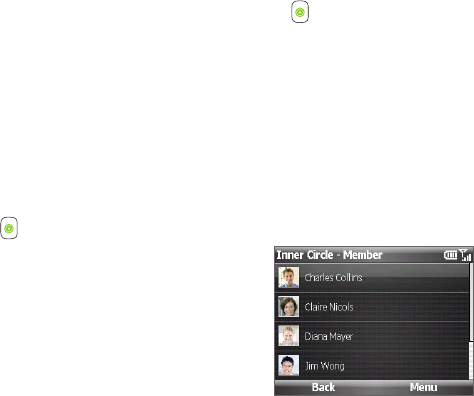
70 Organizing Information
5.2 Using Inner Circle™
Inner Circle™ enables you to group your most important contacts together and
access them with the press of a single key. Email messages from your Inner Circle
members are also grouped for quick access.
You need to set up an email account before you can receive and group email
messages from your Inner Circle contacts. For more information on how to set up
an email account, see “Email” in Chapter 6.
To open Inner Circle
Click Start > Inner Circle, or press the Inner Circle key ( ).
Note The first time you open Inner Circle, click Play to view a tutorial that guides you
through the common features of the application. Otherwise, click Skip to display your
contacts list and start selecting the people you want to add to your Inner Circle.
Creating your Inner Circle and viewing email messages
You can add people to your Inner Circle from your contacts list or from email
messages.
Note Only Outlook contacts can be added to your Inner Circle.
To add people to your Inner Circle from the contacts list
Press . Your Outlook contacts list displays.
2. Navigate to a contact, and press the
TRACKBALL to select it. Repeat the process to
select more contacts.
3. When you are nished selecting all the
desired contacts, click Add.
Your Inner Circle contacts are displayed on
the screen.
1.
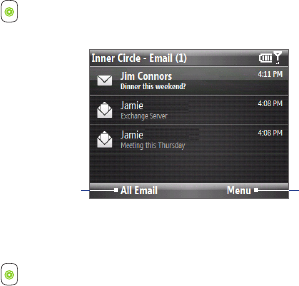
Organizing Information 71
To add people to your Inner Circle using their email address
On the Member screen, click Menu > Add, and then click Menu > New.
Enter the email address of the contact you want to add, and then click OK.
To add the email sender to your Inner Circle
From the email account inbox, select or open an email message.
Click Menu > Add to Inner Circle, and then click OK on the confirmation
screen.
To view email messages from Inner Circle contacts
Press . All email messages from Inner Circle contacts are displayed.
Select an email and press the TRACKBALL to open it.
Open the Messaging
accounts screen
Click to sort,
send/receive,
and search email
in Inner Circle,
and more
Managing your Inner Circle
To search for a contact in your Inner Circle
Press , and then click Menu > Member List to access the Member screen.
Click Menu > Search Member.
Start entering the contact name in the search box. The list displays contacts
whose names begin with the letters you entered.
Note Make sure to change to normal text input mode to have the list filtered while you
type.
4. To view the contact details, select the contact and click View or press the
TRACKBALL.
1.
2.
1.
2.
1.
2.
1.
2.
3.
72 Organizing Information
To delete a contact from your Inner Circle
On the Member screen, press Menu > Delete.
Select the contacts that you want to delete, and click Delete.
Click Yes on the confirmation screen.
5.3 SIM Manager
SIM Manager allows you to view the contents of your SIM card and transfer contacts
from your SIM card to your phone and vice versa.
To create a contact on your SIM card
Click Start > Accessories > SIM Manager.
Click New, and then enter the contact name and phone number.
When finished entering information, click Save.
Tip To change contact information on your SIM card, click a contact and edit it.
After changing the contct information, click Save.
To copy SIM contacts to your phone
Click Start > Accessories > SIM Manager.
Select a SIM contact, or click Menu > Select All to select all SIM contacts.
Click Menu > Save to Contacts.
To copy phone contacts to the SIM card
1. On the SIM Manager screen, click Menu > Contacts to SIM.
2. Select the check boxes of the contact’s phone numbers that you want to copy
to your SIM card, and then click Save.
Only one phone number per contact name can be stored on a SIM card. If the
phone contact has multiple contact numbers, SIM Manager displays each contact
number separately and appends an indicator at the end of each contact type. By
default, /M, /W, and /H are appended to indicate mobile, work, and home phone
numbers respectively.
1.
2.
3.
1.
2.
3.
1.
2.
3.
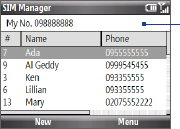
Organizing Information 73
To display your phone number in SIM Manager
On the SIM Manager screen,
click Menu > Tools > List of
Own Numbers.
Click Edit.
Change the name, if desired,
and then enter your mobile
phone number.
Click Save.
1.
2.
3.
4.
When your phone
number is stored
on the SIM card,
it will appear on
the SIM Manager
screen.
5.4 Calendar
Use Calendar to schedule appointments, including meetings and other events.
If you use Outlook on your PC, you can synchronize appointments between your
phone and PC.
Creating an appointment
On the Home screen, click Start > Calendar.
Click Menu > New Appointment.
Enter information about the appointment.
To schedule an all-day event, in End time, select All day event.
To make the appointment recurring, scroll down to Occurs, and then
select the recurring time.
Click Done.
Note All-day events do not occupy blocks of time in Calendar; instead, they appear in
banners at the top of the calendar.
1.
2.
3.
•
•
4.
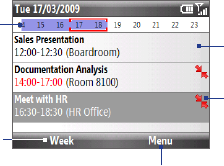
74 Organizing Information
Viewing your appointments
You can view your schedule in Month, Week, or Agenda view.
On the Home screen, click Start > Calendar.
Click the LEFT SOFT KEY or click Menu to choose the view you want.
Highlighted areas
represent time
segments that
have scheduled
appointments.
Change the
calendar view.
Click an
appointment to
view its details.
Agenda View
Indicates that the
scheduled appointment
has a conflict with
one or more existing
appointments.
Change the
calendar options.
Sending meeting requests and appointments
You can send meeting requests via email to persons that use Outlook or Outlook
Mobile. You can also send a calendar appointment to another phone using MMS.
To send a meeting request
Click Start > Calendar.
Schedule a new appointment (or open an existing appointment) and then
scroll down to Attendees and click No Attendees. Click Add Required
Attendee or Add Optional Attendee to add the contacts you want to send
the meeting request to.
Choose the contacts you want to send the meeting request to and click Select.
On the New Appointment screen, click Done. The meeting request is sent out.
1.
2.
1.
2.
3.
4.
Organizing Information 75
Notes • You can only set an attendee as required or optional if your phone is connected
to a Microsoft Exchange 2007 server. Otherwise, all attendees are designated as
required. For more information, see Chapter 7.
• To remove an attendee from the list, select the attendee and click
Menu > Remove Attendee.
• When attendees accept your meeting request, the meeting is automatically
added to their schedules. When their response is sent back to you, your calendar is
updated as well.
To send a calendar appointment
On the Home screen, click Start > Calendar.
Select an appointment, and then click Menu > Send as vCalendar.
Enter the recipient in the To field of the MMS message, and then click Send.
5.5 Tasks
Use Tasks to keep track of things you need to do.
To create a task
On the Home screen, click Start > Tasks.
Click Menu > New Task.
Enter the task information, set the task priority, set a reminder, or put the task
in a category.
When finished, click Done.
Notes • You can synchronize information on your phone with your PC to keep your task list
up to date in both locations.
• If you create a new task with a reminder on your PC and then synchronize tasks
with your phone, the reminder will play at the time that was set on your PC.
To search a task
On the Home screen, click Start > Tasks.
1.
2.
3.
1.
2.
3.
4.
1.
76 Organizing Information
In the task list, do one of the following:
To sort the list, click Menu > Sort by, and click a sort option.
To lter the list by category, click Menu > Filter, and click the category
you want displayed.
To mark a task as completed
On the Home screen, click Start > Tasks.
Select the task, and click Complete.
5.6 Voice Notes
Use Voice Notes to create short voice recordings. Voice notes are included in the
All Notes list and are named consecutively (Recording1, Recording2, and so on).
To create a voice note
On the Home screen, click Start > Accessories > Voice Notes.
Hold the phone’s microphone close to your mouth, and then click Record.
Record your voice note, and click Stop when finished.
To delete a voice note
On the Home screen, click Start > Accessories > Voice Notes.
Select the voice note to delete, and then click Menu > Delete.
Click Yes when prompted.
To listen to a voice note
On the Home screen, click Start > Accessories > Voice Notes.
Select the voice note to play, and press the TRACKBALL.
To use a voice note as a ring tone
On the Home screen, click Start > Accessories > Voice Notes.
Select the voice note, and click Menu > Set As Ringtone.
2.
•
•
1.
2.
1.
2.
3.
1.
2.
3.
1.
2.
1.
2.

Chapter 6
Exchanging Messages
6.1 Messaging
Messaging is where all of your email, text message, and MMS accounts are located.
To access your message accounts, click Start > Messaging and then click the
account you want to open.
Tip You can also press to quickly access Messaging.
While inside a messaging account (for example, SMS/MMS Inbox), click
Menu > Tools > Switch Accounts to switch to another messaging account.
Changing the messaging account settings
On the Messaging screen, select the messaging account you want to change and
click Menu > Settings. You can also change the messaging account settings while
on the message list by clicking Menu > Tools > Options.
Copying text in messages
Copy words or lines of text form your text or email messages and then paste them
on the current or new message.
To copy text while composing a message
While composing the message, position the cursor to the beginning of the
text you want to copy.
Click Menu > Copy/Paste > Select Text.
1.
2.
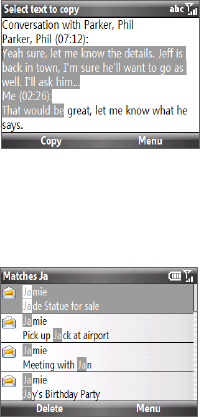
78 Exchanging Messages
Roll the TRACKBALL left or right until you have selected the text you want to
copy, and then click Copy.
Position the cursor where you want to paste the text, and then click
Menu > Copy/Paste > Paste.
To copy text from a received message
Open the message.
Click Menu > Copy/Paste > Select Text.
Use the TRACKBALL to position the cursor
where you want to begin copying and
then click Select.
Tip Click Menu > Select All to select the
whole message.
1.
2.
3.
4. Roll the TRACKBALL left or right until you have selected the text you want to
copy, and then click Copy.
Tip You can also roll the TRACKBALL up or down to select lines of text.
To lter the Inbox message list
Filter SMS and email messages in your Inbox
to only display the messages that contain the
sender or email subject you are searching for.
Enter the sender name or email subject you
want to look for using the keyboard.
As you press keys, the list narrows down to the
conditions you set.
For example, pressing “J” then “A” narrows the
list to only the email messages that contain
sender names and email subjects that start
with “JA.”
3.
4.
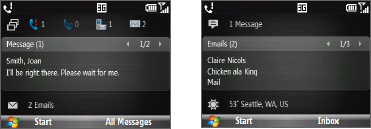
Exchanging Messages 79
Receiving messages on the Home screen
When you receive a new text, MMS, or email message, a snippet of the message is
displayed in the Messages and Emails panels of the Home screen. Simply scroll to
the relevant panel where the new message is and then click it to open and read the
complete message.
New email messageNew text/MMS message
6.2 Text Messages
Send short text messages (SMS) to other mobile phones. If your message is more
than 160 characters, it will be sent as two or more separate messages and you will
be billed accordingly.
Composing and sending text messages
On the Home screen, scroll to the Messages panel and then press the TRACKBALL.
Note If you have unread messages, you will need to scroll right until you see
New Message before pressing the TRACKBALL.
Click Text message.
Enter the mobile phone number of one or more recipients in the To field,
separating them with a semicolon ( ; ). You can also click the To field
or click
Menu > Add Recipient to access phone numbers in Contacts
.
1.
2.
3.
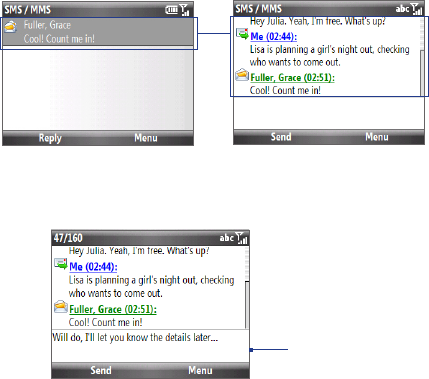
80 Exchanging Messages
Compose your message. You can enter up to 160 characters in one message.
When finished, click Send.
Tips • To cancel the text message, click Menu > Cancel Message.
• If you want to know whether your text message has been received, before sending
the message, click Menu > Message Options and select Request message
delivery notification.
Managing text messages
Text messages that are sent to and received from a contact (or number) are
grouped as a single thread in your inbox. Threaded SMS lets you see exchanged
messages (similar to a chat program) with a contact on the screen.
To reply to a text message
In the SMS/MMS inbox, click a message thread to open it.
At the bottom of the screen, enter your reply message and click Send.
Enter your reply
message here
4.
5.
1.
2.

Exchanging Messages 81
To copy a message in the thread to the SIM card
In the SMS/MMS inbox, click the message to open it.
Scroll up or down to select a message in the thread that you want to copy to
the SIM card.
Note You cannot copy a sent message from the thread to the SIM card.
Click Menu > Copy to SIM.
To copy a text message from the SIM card to the phone
In the SMS/MMS inbox, click the SIM message (preceded by this icon - ) you
want to copy.
Click Menu > Copy to Phone.
Note Copying SIM text messages to your phone results in duplicate messages in the Inbox
folder when your SIM card is in use.
To delete a message in the thread
In the SMS/MMS inbox, click a message thread to open it.
Scroll up or down to select a message in the thread that you want to delete.
Click Menu > Delete.
To delete a message thread
In the SMS/MMS inbox, select a message thread.
Click Menu > Delete.
To reply to a text message with an MMS message
You can reply to a text message in a thread or to a SIM text message using an MMS
message.
In the SMS/MMS inbox, click a message thread to open it.
Click Menu > Insert, and then in the menu, select the item you want to insert:
Picture/Video, Audio or Attachment.
1.
2.
3.
1.
2.
1.
2.
3.
1.
2.
1.
2.
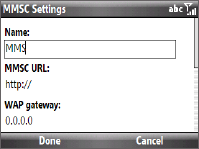
82 Exchanging Messages
Tip Click Menu > Advanced Composer after adding a picture/video, audio, or
attachment to compose an MMS message complete with text, emoticons, media
and attachments. You can also insert a vCard or vCalendar in your MMS message.
Click Send.
6.3 MMS
Creating and sending MMS (Multimedia Message Service) messages to your friends
and family is fun and easy.
Note MMS is a charged service and must be provisioned with your mobile phone plan.
Contact your wireless service provider to have MMS provisioned as part of your call
plan.
Editing MMS settings
Check your phone to see if it is preconfigured with your wireless service provider’s
MMS settings. Add the MMS settings of your wireless service provider if there are no
preset MMS settings found on your phone.
To congure MMS settings
Click Start > Settings > MMS Setting to open the Preferences screen.
Select or clear the provided check boxes according to your needs.
On the Preferences screen, click Menu > MMSC Settings to access
Multimedia Messaging Service Center (MMSC) settings.
If there are no preset settings, click
Menu > New and enter the needed
information. You can get the information
from your wireless service provider:
Click Done. The MMS server settings will
then be added as an entry on the MMSC
Settings screen.
4.
5.
3.
1.
2.
3.
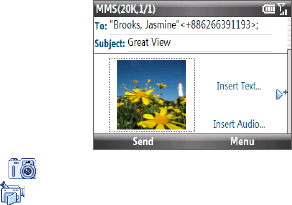
Exchanging Messages 83
Note If you add several MMS service providers to the MMSC Settings screen, you can
choose one as your default MMS provider. Select the MMS provider’s name in the list,
and then click Menu > Set as Default.
Creating and sending MMS messages
You can compose MMS messages in a combination of various slides, where each
slide can consist of a photo, audio or video clip, and/or text.
Note Make sure the size of the MMS is within the limits of the wireless service provider
while sending it to another mobile phone user or to an email address.
On the Home screen, scroll to the Messages panel and then press the TRACKBALL.
Select Media message, and then press the TRACKBALL.
3. In To, enter the recipient’s phone number
or email address.
4. In Subject, enter a subject for your
message.
5. Click Insert Picture/Video to select a
photo or video clip from the Select Media
screen and insert it.
To capture a new photo, click , or click Menu > Capture Image.
To record a new video, click , or click Menu > Capture Video.
6. Click Insert Text to enter text. To insert predened text or emoticons, click
Menu > Insert My Text or Insert Emoticon.
7. Click Insert Audio to insert an audio clip. Select an audio clip on the Select
Audio screen. You can also record a new audio clip by clicking
Menu > Capture Audio.
8. After inserting an MMS message element, scroll right to add a new slide, if
desired.
1.
2.
•
•

84 Exchanging Messages
9. When nished composing the message, click Send.
Notes • To send a copy of this message to others, highlight the To field and then scroll up
to display the Cc and Bcc fields.
• To remove the photo, text, or audio, select the item and press BACK.
Viewing and replying to MMS messages
You can view MMS messages in several ways.
On the message thread, click the MMS message. MMS messages have this
icon ( ). Click Pause or Menu > Stop to pause or stop the message
playback.
Click Menu > Contents View to see a list of files included in the message.
To open a file, select it and click Open or Play. To save a file, select it, and click
Menu > Save File, Menu > Save Audio or Video, or Menu > Save Photo.
View each slide included in the message by scrolling right or left, or by
clicking Menu > Next or Previous.
To reply to an MMS message
In the SMS/MMS inbox, scroll up or down to select the mobile phone number
or name of the contact who sent you the MMS message.
In the threaded message, MMS messages will have the icon. Click this icon
to open and view an MMS message.
After viewing the MMS message, click Menu > Reply > via MMS to reply with an
MMS message or click Menu > Reply > via SMS to reply with a text message.
To block a phone number from sending you MMS messages
If you do not want to receive MMS messages from a particular sender, you can add
the sender’s phone number to the MMS Blacklist.
When you receive a new MMS message, open and view the message.
To avoid receiving MMS messages from this sender next time, click
Menu > Show > Message Detail.
•
•
•
1.
2.
3.
1.
2.
Exchanging Messages 85
On the Message Detail screen, click Menu > Show Contact Details.
Click Menu > Save to Blacklist, and then Click Done.
Tip To unblock a phone number and allow the sender to send you MMS messages, remove
the number from the Blacklist. Click Start > Settings > MMS Setting > Menu >
Edit Blacklist. In the Blacklist screen, select the contact and click Menu > Delete.
6.4 Email
Setting Up Email Accounts
Before you can send and receive email, you need to set up your email account on
your phone. You can set up the following types of email accounts on your phone:
• Outlook e-mail that you sync with your computer or the Exchange Server.
• E-mail account that you have from an Internet Service Provider (ISP) or other
e-mail provider.
• Web-based e-mail accounts such as Yahoo!® Mail Plus or AOL®.
• Custom domain e-mail accounts. The e-mail domain name is hosted by a
dierent e-mail provider.
• Work account that you access using a VPN connection.
Synchronizing Outlook email with your computer
If you have installed the synchronization software on your PC and created a
partnership with your phone, then your phone is ready to send and receive Outlook
email. If you have not yet installed the synchronization software or created a
partnership, follow the procedures in Chapter 3.
Tip To set up your company email account so that you can access Outlook email
messages wirelessly, you must set up your phone to synchronize via an over-the-
air connection with your company’s Exchange Server. For more information about
synchronizing with your company email server, see Chapter 7.
3.
4.
86 Exchanging Messages
Setting up an Internet email account
Set up a POP3 or IMAP4 email account on your phone if you have an email account
from an Internet service provider (ISP), or a Web-based account such as Yahoo!
Mail Plus, etc. You can also add a work account that you access using a VPN server
connection as a POP3/IMAP4 account.
Click Start > Messaging > Setup Email.
Enter the Email address and Password for the email account and select the
Save password option. Click Next.
Click Next.
Note Email Setup searches your phone for preloaded email configuration settings. If
the phone cannot find the server settings for the specified email account, your
phone needs to connect to the Internet and try to download the settings. If it
cannot find the settings online, you need to enter the settings manually.
Enter Your name and the Account display name and then click Next.
In the Automatic Send/Receive list, choose how frequent you want email
messages to be automatically sent and downloaded on your phone.
Note Click Review all download settings to select download options, set the email
format as HTML or plain text, and more. For more information, see “To customize
download and format settings.“
Click Finish.
To specify email server settings
If Auto Setup is unsuccessful, contact your ISP or email provider for the incoming
mail server and outgoing mail server settings so you can enter them on your phone.
Other options that you can select include the following:
Select the Outgoing server requires authentication check box, if required
by your provider.
If the outgoing email server requires a different user name and password
for sending email, clear the Use the same user name and password for
sending email check box. You will be prompted to enter these information.
1.
2.
3.
4.
5.
6.
•
•

Exchanging Messages 87
Click Advanced Server Settings, then select the Require SSL check boxes if
your email provider uses an SSL connection for more secured email.
From the Network connection list, select the data connection that you use
for connecting to the Internet.
To customize download and format settings
Before you click Finish when setting up your Internet email account, you can click
Review all download settings to choose download options, message format, and
other settings. Click Advanced Settings for further options.
Options Description
Automatic Send/Receive You can select a time interval for connecting to the Internet
automatically to send and receive messages.
Download messages Set the number of days of messages that you want to be
downloaded to your phone.
Send/receive when I
click Send
By default, messages are immediately delivered when you click
Send. If you prefer to save outgoing messages to the Outbox
folder first, clear the check box. (In this case, you will need to
manually send messages by clicking Menu > Send/Receive).
Use automatic send/
receive schedule when
roaming
This allows your phone to data roam when there is a set time
interval for connecting to the Internet automatically. Since this
may result in higher connection costs, you may want to leave the
check box cleared.
When deleting messages
Choose whether to delete messages from the mail server when
you delete them on your phone.
Message format
Select HTML or Plain Text.
Message download limit
Select the email download size. If you have large volumes of
email, use a lower size or select to download headers only.
Download attachments
Set your preference when there is an email attachment
•
88 Exchanging Messages
Creating and sending email messages
After setting up email accounts on your phone, you can start sending and receiving
email messages.
To compose and send an email
Click Start > Messaging, and then select an email account.
Click Menu > New.
Enter the email address of one or more recipients, separating them with a
semicolon. To access email addresses stored in Contacts, in To, click Menu >
Add Recipient. Select a contact from the list and press CENTER OK.
Enter a subject and compose your message. To quickly add common
messages, click Menu > My Text and click a desired message.
Click Send.
Tips • To set the priority, click Menu > Message Options.
• If you are working offline, email messages are moved to the Outbox folder and will
be sent the next time you connect.
To add an attachment to an email
In the message that you are composing, click Menu > Insert and click the
item you want to attach: Picture, Voice Note, or File.
Select the file you want to attach, or record a voice note.
Viewing and replying to email messages
When you receive a email message, a snippet of the message is displayed in the
Emails panel of the Home screen. Scroll to the panel and then click it to open and
read the complete message.
To download a complete email
By default, each email in the inbox on your phone contains only the first few kilobytes
of the message. When you open an email, it displays only the headers and part of the
message. You must download the whole email to view the complete content.
1.
2.
3.
4.
5.
1.
2.
Exchanging Messages 89
To download a complete email message, open the email and then do one of the
following:
Scroll down to the end of the message and click Get the rest of this message.
Click Menu > Download Message.
Note The Fetch Mail feature, which is available for POP3 and IMAP4 Internet email accounts,
downloads an entire email without the need for you to perform a full synchronization.
This limits the download to just the email message that you want and helps save data
cost. Fetch Mail is also available for Outlook Email. See “Instant download through
Fetch Mail” in Chapter 7 for details.
To download an attachment
In an open message with an attachment to download, click the attachment. If there
is more than one attachment, click the other attachments to download them. You
can directly open the file in the associated program after you download them by
clicking the attachment again.
To reply to or forward an email
Open the message and click Menu > Reply > Reply, Reply All, or Forward.
Enter your response, and click Send.
Notes • You can receive and view HTML email messages from any type of email account.
The HTML format is retained, without layout shifting or resizing. HTML email
support in Outlook Mobile is available only if you are synchronizing your phone
with Microsoft Exchange Server 2007.
• When replying using an Outlook email account, you can customize ActiveSync to
exclude addresses, including your own, from being added to the recipient list. Click
Menu > Options in ActiveSync, select the Email item and then click Settings.
In the Email Sync Options screen, click Menu > Advanced and then in the
My email addresses text box, enter email addresses you want to exclude.
•
•
1.
2.
90 Exchanging Messages
Synchronizing email messages
Synchronizing email messages ensures that new email messages are downloaded
to the phone Inbox folder, email messages in the Outbox folder are sent, and email
messages deleted from the server are removed from your phone. The manner in which
you synchronize email messages depends on the type of email account you have.
To automatically synchronize an Outlook email account
Connect your phone to your computer through USB or Bluetooth.
Otherwise, connect through Wi-Fi or a data connection if you are synchronizing
Outlook email with the Exchange Server. For more information, see Chapter 7.
2. Synchronization automatically begins, and your phone sends and receives
Outlook email.
To manually synchronize your Outlook or Internet email account
Select your email account.
Click Menu > Send/Receive.
Customizing email settings
To change the download size and format for Outlook email
Disconnect your phone from the computer.
Click Start > ActiveSync.
Click Menu > Options, select Email, then click Settings.
On the Email Sync Options screen, set the Download size limit and
Message format.
Click Done.
To change the download size and format for POP3/IMAP4 email
On the POP3/IMAP4 email message list, click Menu > Tools > Options >
Account Settings > Download Size Settings.
Configure the Message format and Message download limit settings.
Click Done.
1.
1.
2.
1.
2.
3.
4.
5.
1.
2.
3.

Chapter 7
Working with Company Email and
Meeting Appointments
7.1
Synchronizing with Your Company Email Server
Synchronize your phone with your company’s Microsoft Exchange Server to keep
you connected with your emails, contacts, calendar, and other information.
Setting up a company email server connection
Use your phone to access your company emails by setting up an Exchange Server
connection. You can get the company email server information from your network
administrator:
Click Start > Messaging > Setup Email.
Enter the Email address and Password for the email account and select the
Save password option. Click Next.
Clear the Try to get email settings automatically from the Internet option
and click Next.
In Your email provider, select Exchange server and click Next.
Click Next again.
Select the Attempt to detect Exchange Server Settings automatically
option and click Next.
Enter the Domain name and click Next.
In Server address, enter the Exchange Server address and click Next.
1.
2.
3.
4.
5.
6.
7.
8.
92 Working with Company Email and Meeting Appointments
Select the items that you want to sync with the Exchange Server and click
Finish.
Note Before clicking Finish, click Menu > Advanced to change the rules for resolving
synchronization conflicts.
If you need to change the Exchange Server settings, open ActiveSync on your
phone and click Menu > Configure Server.
Note If you synchronized emails with your PC before, open ActiveSync on your phone and
click Menu > Add Server Source to set up an Exchange Server connection. When
you are prompted to select information types for synchronization, you need to clear
the Email check box under the Windows PC item first before you can select the Email
check box under Exchange Server.
Starting synchronization
Before you start synchronizing with the Exchange Server, make sure your phone
has been set up with a data connection to the Internet or Wi-Fi so that you can
synchronize wirelessly. See Chapter 8 for details.
After you finish setting up an Exchange Server connection, your phone
automatically starts synchronization. You can manually start synchronization
anytime by clicking Sync in ActiveSync.
Note If you connect your phone to your office computer via a USB or Bluetooth connection,
you can use this connection to the PC to “pass through” to the network and download
Outlook emails and other information to your phone.
7.2 Working with Company Emails
Your phone gives you instant access to your company emails and lets you manage
your messages easier. Messaging features such as Direct Push, Fetch Mail, and
Filtering messages are just some of the tools you can use to manage your emails.
Note
Some messaging features depend on the Microsoft Exchange Server version used. Check
with your network administrator for the availability of Exchange Server features.
9.
Working with Company Email and Meeting Appointments 93
Automatic synchronization through Direct Push
Direct Push technology (push email feature) enables you to receive new emails on
your phone as soon as they arrive in your Inbox on the Exchange Server. With this
feature, items such as contacts, calendar and tasks are also immediately updated
onto your phone when these items have been changed or new entries have been
added on the Exchange Server. To make Direct Push work, you need to have a Wi-Fi or
data connection on your phone. You need to perform a full synchronization between
your phone and the Exchange Server first before Direct Push can be enabled.
Requirement The Direct Push feature works for your phone only if your company is using
Microsoft Exchange Server 2003 Service Pack 2 (SP2) with Exchange
ActiveSync or higher version.
To enable Direct Push via Comm Manager
Click Start > Accessories > Comm Manager.
On the Comm Manager screen, click the Microsoft Direct Push option. When
ON, you will receive emails as they arrive. When OFF, you need to manually
retrieve your emails.
Scheduled synchronization
If you do not want to use Direct Push, you can set a regular schedule for
synchronizing Outlook email and information.
In ActiveSync on your phone, click Menu > Schedule.
Select a shorter time interval in the Peak times box for you to be able to
receive emails more frequently.
Select a longer interval in the Off-peak times box.
Tip Click Menu > Peak Times to set the peak and off-peak times.
1.
2.
1.
2.
3.
94 Working with Company Email and Meeting Appointments
Instant download through Fetch Mail
Fetch Mail downloads an entire email immediately without the need for you to
perform a full Send/Receive action.
Requirement Fetch Mail works for your phone only if your company is using Microsoft
Exchange Server 2007 or higher.
Click Start > Messaging > Outlook Email.
Click an email message to open it.
By default, only the first few kilobytes of the message is shown. To download
the whole email, scroll to the bottom of the message then click Get the rest
of this message.
A “Downloading message” status appears. Wait for the remainder of the
message body to be downloaded.
Notes • For information about changing email sync options such as setting the download
size for email, see “Customizing email settings” in Chapter 6.
• When you receive an email that contains a link to a document such as a PDF or
Microsoft Office document located on SharePoint or an internal file server, you can
click the link to view the document on your phone. You can view the document
only if you have a Microsoft Outlook account that synchronizes with Microsoft
Exchange Server 2007 or later. Exchange Server must also be set up to allow access
to SharePoint document libraries or internal file servers.
Searching for emails on the Exchange Server
You can access messages that are not available on your phone by searching your
Microsoft Exchange Server mailbox. The search results will be downloaded and
displayed in a Search Results folder.
Requirement Your company must be using Microsoft Exchange Server 2007 or higher.
Click Start > Messaging > Outlook Email.
Click Menu > Tools > Search Server.
1.
2.
3.
4.
1.
2.
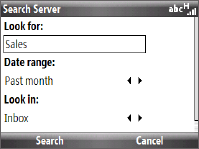
Working with Company Email and Meeting Appointments 95
3. In the Look for text box, enter the search
keyword.
4. Choose the Date range of messages to
search from and where to search in Look in.
5. Click Search.
Out-of-office auto-reply
Outlook Mobile allows you to retrieve and change your out-of-office status. Just like
desktop Outlook Email, Outlook Mobile automatically sends an auto-reply message
when you’re not available.
Requirement Your company must be using Microsoft Exchange Server 2007 or higher.
To send out-of-oce auto-reply messages
Click Start > Messaging > Outlook Email.
Click Menu > Tools > Out of Office.
From the I am currently list, select Out of the Office.
Enter your auto-reply message then click Done.
Flagging your messages
Flags serve as a reminder to yourself to follow-up on important issues or requests
that are indicated in the messages.
Requirement Flags are enabled only if emails are synchronized with Microsoft
Exchange Server 2007 or higher. Flags are disabled or hidden if emails are
synchronized with earlier versions of Microsoft Exchange Server.
To flag or unflag a message
Click Start > Messaging > Outlook Email.
Select a message, or open a message.
1.
2.
3.
4.
1.
2.
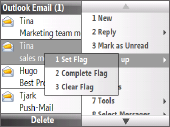
96 Working with Company Email and Meeting Appointments
Click Menu > Follow Up and select one of the following options:
Set Flag. Mark the message with a red
ag to indicate that it needs follow up.
Complete Flag. Mark the message
with a check mark to indicate that the
issue or request in the email is already
completed.
Clear Flag. Remove the ag to unmark
the message.
•
•
•
Note Email message reminders are displayed on your phone if the messages are flagged
with reminders and synchronized from the Exchange Server.
7.3 Managing Meeting Requests
When you schedule and send meeting requests from your phone, you can invite
attendees to your meeting and check their status to know their availability.
When you receive a meeting request, you can reply by accepting or declining
the request. The meeting request also clearly indicates whether or not there are
conflicting or adjacent meetings.
Requirement Your company must be using Microsoft Exchange Server 2007 or higher.
To view the list of meeting attendees
Click Start > Calendar.
Click a meeting request that you sent and then click Attendees. The required
and optional attendees will be listed. Icons indicating whether each attendee
has accepted or declined the meeting request will also be displayed.
Note To see the icon indicators in the attendees list, make sure Calendar is synchronized
with the Exchange Server.
3.
1.
2.

Working with Company Email and Meeting Appointments 97
To reply to a meeting request
When there’s an incoming email with a meeting request, a notification
message will be displayed on your phone’s Home screen. Scroll to the Email
panel and click it.
In the Outlook message list, click the email to open it.
Click Accept to reply and accept the meeting request, or click Menu >
Decline if you cannot attend the meeting.
Tips • Before responding, you can check your availability during the time of the
requested meeting by clicking View your calendar.
• If the time of the meeting conflicts with your other appointments, a
“Scheduling Conflict” status appears on top of the email.
Choose whether or not to edit the response email before sending and then
click Done:
If you accepted the meeting request, it will automatically be added as an
appointment in Calendar on your phone.
1.
2.
3.
4.
5.
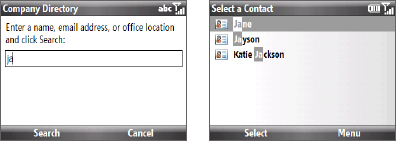
98 Working with Company Email and Meeting Appointments
7.4 Finding Contacts in the Company Directory
In addition to having contacts on your phone, you can access contact information
from your organization’s Company Directory.
Requirement Access to the Company Directory is available only if your organization is
running Microsoft Exchange Server 2003 SP2 or higher, and you have
completed your first synchronization with the Exchange Server.
Synchronize with Exchange Server if you have never done so.
Do any of the following:
In Contacts, click Menu > Company Directory.
In a new email, click the To box and then click Company Directory at the
top of the list or click Menu > Company Directory.
In a new meeting request using Calendar, scroll to Attendees and click
No attendees > Add Required Attendee or Add Optional Attendee and
then click Company Directory at the top of the list.
Enter the part or full contact name and click Search. In the search results list,
click a contact to select it.
Notes • You can save a contact from the Company Directory to your phone by selecting
the contact and then clicking Menu > Save to Contacts.
• You can search on the following information as long as that information is included
in your organization’s Company Directory: First name, Last name, Email name,
Display name, Email address, or Office location.
1.
2.
•
•
•
3.
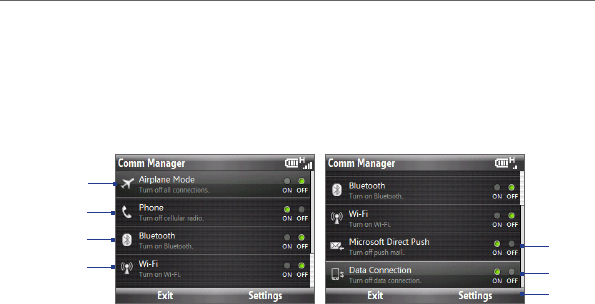
Chapter 8
Getting Connected
8.1 Using Comm Manager
Comm Manager acts like a central switch that lets you enable or disable phone
features as well as manage your device connections easily.
To open Comm Manager:
Click Start > Accessories > Comm Manager.
1
2
3
4
5
6
7
1Turn Airplane mode on or off. Turning on Airplane mode disables
the phone and wireless functions including Bluetooth, Wi-Fi, and
your data connection.
2Enable or disable the phone function.
3Enable or disable Bluetooth. See “Bluetooth” for details.
4Enable or disable Wi-Fi.
5Toggle between automatically receiving (as items arrive) or
manually retrieving Outlook emails. See Chapter 7 for details.
6Enable or disable data connection.
7Access the phone, Bluetooth, and Wi-Fi settings, and phone profiles.

100 Getting Connected
8.2 Connecting to the Internet
Your phone’s networking capabilities allow you to access the Internet or your
corporate network at work through Wi-Fi, GPRS/3G, or dial-up. You can also add and
set up a VPN or proxy connection.
Wi-Fi
Wi-Fi provides wireless Internet access over distances of up to 100 meters.
Note The availability and range of your phone’s Wi-Fi signal depends on the number,
infrastructure, and other objects through which the signal passes.
To connect to a Wi-Fi network
On the Home screen, click Start > Accessories > Comm Manager and click
the Wi-Fi icon to turn Wi-Fi on.
After a few seconds, a message asks you if you want to see the list of available
networks, click Yes.
In Select network, choose the wireless network to connect to.
In Network type, select Internet and click Connect.
When you select an open (unsecured) network, you will be automatically
connected to the network after clicking Connect.
If you are connecting to a security-enabled network, you will be asked to
enter the WEP Key. Enter the WEP Key and click Done.
You can check the Wi-Fi icon ( ) on the title bar to see if you are connected to the
Wi-Fi network.
Note In Comm Manager, click Settings > WLAN Settings > Connection Status to check
the current connection status and signal quality..
1.
2.
3.
4.
•
•
Getting Connected 101
To increase security on the Wi-Fi network
The LEAP (Lightweight Extensible Authentication Protocol) helps increase security
on your phone, and ensures that nobody is able to access your network without
your permission.
On the WLAN Settings screen, select LEAP.
Click Menu > New.
Enter the SSID (Service Set Identifier). You can obtain this information from
your wireless service provider.
Enter the user name, password, and domain.
Select an Authentication Type.
By default, the Authentication Type for your phone is Open System
authentication.
Notes • By default, the LEAP screen displays data that you entered previously. However,
you can modify or delete the data as required by clicking Menu > Modify or
Menu > Delete on the LEAP screen.
• For LEAP to work correctly, the receiving phone (your phone) must be set with the
same SSID, user name, and password as the access point.
GPRS/3G
Use GPRS/3G (or EDGE, if available) to connect to the Internet and to send and
receive email and MMS on your phone. You will need a data plan to use your
wireless service provider’s GPRS/3G network. Check with your wireless service
provider to find out about GPRS/3G rates.
GPRS/3G settings are already preconfigured on your phone, and your phone is
ready to use your wireless service provider’s GPRS/3G services. Do not change the
settings as this may cause services to stop working. If you need to add another
GPRS/3G connection on your phone, contact your wireless service provider.
1.
2.
3.
4.
5.
102 Getting Connected
Dial-up
When you use your phone to dial up to your ISP and connect to the Internet or to
your corporate network, you will be billed by the number of minutes that you use.
To set up a dial-up connection
On the Home screen, click Start > Settings > Connections > Dial-up > New.
In Description, enter a name for the connection.
Do any of the following:
If you are using the connection to access the Internet, select The Internet
in Connects to.
If you are using the connection to access your corporate network, select
Work in Connects to.
4. Enter the appropriate information in the remaining elds, and then click
Done.
Adjusting advanced connection settings
Access advanced options to specify the service provider, the number of redial
attempts, the amount of idle time to wait before disconnecting, and more.
On the Home screen, click Start > Settings > Connections > Menu >
Advanced.
Select a network service provider for each connection type. You can choose
Automatic to allow the phone to set a service provider for each connection
by default.
Click Menu > Options.
Choose the appropriate information in the remaining fields, and then click
Done.
1.
2.
3.
•
•
1.
2.
3.
4.

Getting Connected 103
8.3 Internet Explorer Mobile
Internet Explorer Mobile is a full-featured Internet browser, optimized for use on
your phone.
Browsing the Web
On the Home screen, click Start > Internet Explorer.
Click Menu > Go to Web Address.
Enter the web address and click Go.
Use the TRACKBALL to browse the web page. Press the TRACKBALL when a
link is highlighted to access it.
While browsing the Web, click Menu to open a list of options that will let you
change the view, save Favorites, and set Internet Explorer Mobile preferences, and
more.
Click Menu > Add to
Favourites to save the
current Web page in your
Favorites folder. Click
Favourites to access your
Favorites folder.
Click Menu > Tools
and choose to send the
link via email, view the
page’s properties, or set
Internet Explorer Mobile
preferences.
Click Menu > View and
then select the text size
and type of view you want
to use while browsing a
Web page.
1.
2.
3.
4.
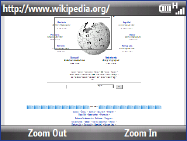
104 Getting Connected
Navigating web pages
Navigating large-sized web pages is easy using the zoom feature of Internet
Explorer Mobile.
Go to the web page that you want to view.
Click Zoom Out.
Use the TRACKBALL to move the box to the
area of the web page that you want to view.
Click Zoom In or press the TRACKBALL to
view the selected area using the selected
zoom level.
1.
2.
3.
4.
Copying web page text
Copy text from a web page and then paste it on a text message or email.
On a web page, click Menu > Copy/Paste > Make Selection.
Use the TRACKBALL to position the cursor where you want to start copying,
and then click Select.
Roll the TRACKBALL left or right until you have selected the text you want
to copy and then click Copy. You can also roll the TRACKBALL up or down to
select whole lines of text.
Adding a URL exception
Some URLs for web pages on your company intranet may use periods, for example,
intranet.companyname.com. To view these pages in Internet Explorer Mobile, you
must create a URL exception.
On the Home screen, click Start > Settings > Connections > Menu >
Advanced.
Click Menu > Work URL Exceptions > Menu > Add.
1.
2.
3.
1.
2.
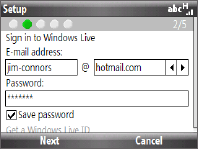
Getting Connected 105
In URL Pattern, enter the URL name. If you are adding multiple URLs,
separate them with a semicolon ( ; ).
Click Done.
Note You do not need to create URL exceptions for Internet URLs.
8.4 Using Windows Live™
Windows Live™ helps you quickly find information using Windows Live™ Search,
access and synchronize your Windows Live™ Mail messages and contacts, and send
instant messages using Windows Live™ Messenger.
To set up Windows Live for the rst time
Click Start > Windows Live.
Click Sign in to Windows Live.
3. On the next screen, click the links to read the Windows Live Term of Use and
the Microsoft Privacy Statement. After reviewing it, click Accept.
4. Enter your Windows Live Mail or Hotmail
address and password, and then click Next.
Choose whether or not to show Windows
Live’s services on the Home screen and then
click Next.
5.
3.
4.
1.
2.
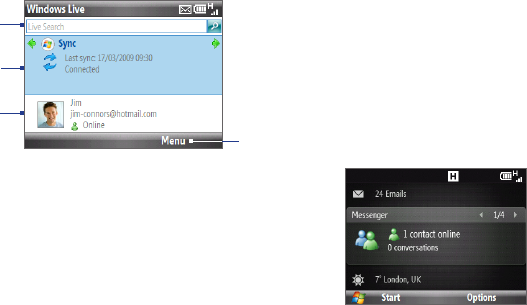
106 Getting Connected
6. Choose what information you want to synchronize online with your phone.
If you select Store Windows Live contacts in your mobile phone’s contact
list, your online contacts will be added to the contact list and to Windows
Live Messenger Mobile on your phone.
If you select Sync e-mail, your Windows Live Mail or Hotmail inbox messages
will be downloaded to your phone.
Click Next.
After synchronization is complete, click Done.
The Windows Live screen
On the main interface of Windows Live, you will see a search bar, navigation bar,
and an area where you can customize to show your picture.
2
1
3
1Windows Live Search bar.
2Scroll left or right to switch among Hotmail/Live
Mail, Messenger, and Sync status. Click to open/
activate the selected Windows Live component.
3Click to access Windows Live Messenger settings.
4Click to access and change settings.
4
If you chose to display Windows Live services on the
Home screen, you will see the selected Windows Live
panel on the Home screen.
To show or hide Windows Live on the Home screen,
click Options > Home screen options on the
Windows Live panel on the Home screen.
7.
8.
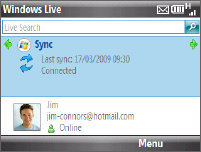
Getting Connected 107
Using Windows Live™ Messenger
With this mobile version of Windows Live™ Messenger, you can send and receive
instant messages.
To sign in to Windows Live™ Messenger and start a conversation
1. Do any of the following:
On the Home screen, click Start > Messenger.
Click the Windows Live Messenger panel of the Home screen, scroll left or
right until you see Messenger, and then press the TRACKBALL.
2. Click Sign in. Signing in may take several minutes, depending on your
connection speed.
3. In the contact list, select an online contact, and then click Send IM to open the
message screen.
4. On the message screen, enter your message in the text eld, and then press
the Enter key to send the message. You can also do any of the following on
the message screen:
• To add an emoticon, click Menu > Add
emoticon, and then click an emoticon
on the screen. The emoticon is attached
to your message.
• To send a file, click Menu > Send,
select the type of file (picture, voice
clip, or any file), and then locate the file
you want to send.
• To invite one or more contacts to the conversation, click Menu >
Options > Add participant.
• To send a voice message, click Voice clip on the message screen, then
start talking. When you have finished recording, click Send.
•
•
108 Getting Connected
5. To end the conversation with the current contact, click
Menu > End conversation.
6. To sign out, click Menu > Sign Out.
To add a Windows Live™ contact
You can add new Windows Live™ contacts in Windows Live™ Messenger.
1. On the Messenger screen, click Menu > Add new contact.
2. Enter the email address of the contact, and then click OK.
To delete a contact
In Messenger, select the contact and click Menu > Contact options >
Remove contact.
Choose whether to block the contact and/or to delete the contact from your
phone’s contact list.
Click OK.
8.5 Internet Sharing (Using Your Phone as a Modem)
With Internet Sharing, you can use your phone as an external modem for another
device such as a PDA phone or notebook computer.
Before you proceed
• Make sure your phone has a SIM card installed, and you have set up a
GPRS/3G or phone dial-up modem connection on your phone. If your phone
has not been set up with a data connection yet, click Menu > Connection
Settings on the Internet Sharing screen. For more information about setting
up a GPRS connection, see “GPRS/3G”. For more information about setting up
a phone dial-up connection, see “Dial-up”.
• Before using Internet Sharing, disable ActiveSync on your computer. To
disable ActiveSync, open ActiveSync then click File > Connection Settings
and clear Allow USB Connections.
1.
2.
3.
Getting Connected 109
Setting up the phone as a USB modem
On your phone, click Start > Accessories > Internet Sharing.
In the PC Connection list, select USB.
In the Network Connection list, select the name of connection that your
phone uses to connect to the Internet.
Connect the phone and your computer using the USB sync cable.
Click Connect.
Setting up the phone as a Bluetooth modem
You can connect your phone to a notebook or desktop computer through
Bluetooth and use the phone as a modem for the computer.
For the computer to use the Internet connection of your phone, activate Internet
Sharing on your phone, and then set up a Bluetooth Personal Area Network (PAN)
between the computer and your phone.
On your phone, turn on Bluetooth and set it to visible mode.
Initiate a Bluetooth partnership from your phone by following the steps in “To
create a Bluetooth partnership.“
Click Start > Accessories > Internet Sharing.
Select Bluetooth PAN as the PC Connection.
From the Network Connection list, select the name of the connection that
your phone uses to connect to the Internet, and then click Connect
On your computer, set up a Bluetooth Personal Area Network (PAN) with your
phone. For instructions, see “To set up a Bluetooth PAN on your computer”.
7. On the Internet Sharing screen on your phone, check whether a connected
status message is displayed, which indicates that your computer has been
successfully connected to the Internet using your phone as a Bluetooth
modem.
1.
2.
3.
4.
5.
1.
2.
3.
4.
5.
6.
110 Getting Connected
To set up a Bluetooth PAN on your computer
For Windows XP
a. Click Start > Control Panel > Network Connections.
b. Under Personal Area Network, click the Bluetooth Network
Connection icon.
c. Under Network Tasks, click View Bluetooth network devices.
d. In the Bluetooth Personal Area Network Devices dialog box, select your
phone, then click Connect.
For Windows Vista
a. Click Start > Control Panel > Network and Sharing Center.
b. Click Manage network connections and then under Personal Area
Network, double-click Bluetooth Network Connection.
c. In the Bluetooth Personal Area Network Devices dialog box, select your
phone, then click Connect.
Note If the Bluetooth adapter or dongle on your computer was installed using a third-party
driver, open the Bluetooth software that came with the Bluetooth adapter/dongle
to connect your computer and MDA Vario V via Bluetooth. Refer to the Bluetooth
adapter/dongle documentation for more information.
Ending the Internet connection
On the Internet Sharing screen, click Disconnect.
•
•
Getting Connected 111
8.6 Bluetooth
Bluetooth is a short-range wireless communications technology. Phones with
Bluetooth capabilities can exchange information within a distance of about 10
meters without requiring a physical connection.
Bluetooth modes
Bluetooth on your phone operates in three different modes:
On. Bluetooth is turned on. Your phone can detect other Bluetooth-enabled
devices, but not vice versa.
Off. Bluetooth is turned off. In this mode, you can neither send nor receive
information using Bluetooth.
Visible. Bluetooth is turned on, and all other Bluetooth-enabled devices
within range can detect your phone.
Note By default, Bluetooth is turned off. If you turn it on, and then turn off your phone,
Bluetooth also turns off. When you turn on your phone again, Bluetooth automatically
turns on.
To turn Bluetooth on and make your phone visible
On the Home screen, click Start > Settings > Connections > Bluetooth.
Click Bluetooth > Menu > Turn On Bluetooth.
Click Menu > Turn On Visibility.
Note To turn off Bluetooth capabilities on your phone, click Bluetooth > Menu >
Turn Off Bluetooth.
Tip Enter a Bluetooth phone name for your phone. This will be the phone name that will
be shown on another Bluetooth-enabled device when it searches and detects your
phone. To enter a name, on the Bluetooth screen, click Security and enter a Device
name.
•
•
•
1.
2.
3.
112 Getting Connected
Bluetooth partnerships
A Bluetooth partnership is a relationship that you create between your phone and
another Bluetooth-enabled device in order to exchange information in a secure
manner.
To create a Bluetooth partnership
On the Home screen, click Start > Accessories > Comm Manager >
Settings > Bluetooth.
Click Bluetooth > Add new device. Your phone searches for other Bluetooth-
enabled devices and lists them on the screen.
Select the device in the list and click Next.
Enter a passcode (1 up to 16 characters) to establish a secure connection, and
then click Next.
Wait for the paired device to accept the partnership. The receiving party
needs to enter the same passcode that you specified.
After the receiving party enters the passcode, a message box appears on your
phone confirming the partnership.
Note Click Advanced to change the paired device name and to set the services you
want to use for the paired device.
Click Done.
Note Creating a Bluetooth partnership between two devices is a one-time process. Once
a partnership is created, the devices can recognize the partnership and exchange
information without entering a passcode again.
To accept a Bluetooth partnership
Ensure that Bluetooth on your phone is turned on and in visible mode.
Click Yes when prompted to establish a partnership with the other device.
Enter a passcode (the same passcode that is entered on the device requesting
the partnership) to establish a secure connection and click Next.
1.
2.
3.
4.
5.
6.
7.
1.
2.
3.
Getting Connected 113
Note Click Advanced to change the paired device name and to set the services you
want to use for the paired device.
Click Done.
To change the display name of a Bluetooth device
On the Home screen, click Start > Accessories > Comm Manager >
Settings > Bluetooth.
Click Bluetooth and then on the screen, select a Bluetooth device.
Click Menu > Edit.
Enter a new display name for the Bluetooth device, and then click Next.
Click Done.
To delete a Bluetooth partnership
On the Home screen, click Start > Accessories > Comm Manager >
Settings > Bluetooth.
Click Bluetooth and then on the screen, select a Bluetooth device.
Click Menu > Delete, and then click Yes on the confirmation screen.
Click Done.
Connecting a Bluetooth hands-free or stereo headset
For hands-free phone conversations or listening to music, you can use a Bluetooth
hands-free or stereo headset.
To connect a Bluetooth hands-free or stereo headset
Make sure that both your phone and the Bluetooth headset are turned on
and that the headset is visible. Refer to the manufacturer’s documentation to
find out how to set the headset in visible mode.
Click Start > Accessories > Comm Manager > Settings > Bluetooth.
Click Bluetooth > Add new device.
4.
1.
2.
3.
4.
5.
1.
2.
3.
4.
1.
2.
3.
114 Getting Connected
Select the name of the Bluetooth headset, and then click Next. The phone
will automatically pair with the Bluetooth headset.
Windows Mobile will automatically try one of the preconfigured passcodes (0000,
1111, 8888, 1234) to pair the Bluetooth headset with the phone. If this fails, you
have to enter the passcode delivered with your headset manually.
Note If the Bluetooth stereo headset becomes disconnected, turn the headset on and
repeat steps 1 to 3 above. Select the stereo headset and click
Menu > Set as Wireless Stereo.
Beaming information using Bluetooth
You can beam information, such as contacts, calendar items, and tasks, as well as
files from your phone to your computer or to another Bluetooth-enabled device.
Notes • If your computer does not have built-in Bluetooth capabilities, you need to
connect and use a Bluetooth adapter or dongle on your computer.
• Before beaming items to your computer, open Bluetooth Configuration or
Bluetooth Settings in the Control Panel and check if there’s an option for setting a
location for saving beamed items.
• Not all file types can be sent via Bluetooth.
To beam information from your phone to a computer
Set Bluetooth on your phone to visible mode. For information about this, see
“To turn Bluetooth on and make your phone visible”.
Set Bluetooth on your computer to visible mode, create a Bluetooth
partnership, and then enable your computer to receive Bluetooth beams.
If your computer has Windows Vista or Windows XP SP2 and your computer’s
Bluetooth adapter is supported by your Windows version, do the following steps:
a. On your computer, open Bluetooth Devices from the Control Panel then
click the Options tab.
For Windows Vista, select Allow Bluetooth devices to nd this
computer.
4.
1.
2.
•
Getting Connected 115
For Windows XP, select Turn discovery on and Allow Bluetooth
devices to connect to this computer.
c. Create a Bluetooth partnership between your phone and computer.
For information about creating a partnership, see “Bluetooth partnerships”.
d. In the Options tab of Bluetooth Devices, select Show the Bluetooth
icon in the notication area.
e. To enable your computer to receive Bluetooth beams, right-click the
Bluetooth icon at the bottom-right of your computer screen and select
Receive a File.
Now you are ready to beam. On your phone, select an item to beam. The item
can be an appointment in your calendar, a task, a contact card, or a file.
Calendar appointment: Open and click Menu > Beam Appointment.
Task: Click Menu > Beam Task.
Contact: Click Menu > Send Contact > Beam.
File: Click Menu > Beam.
Select the device name to which you want to beam to.
Click Beam.
To beam information to a Bluetooth-enabled device such as another phone, create
a Bluetooth partnership then do steps 3 to 5 in the above procedure.
Tips • If you beamed a calendar, task, or contact item to your computer and it is not
automatically added to Outlook, click File > Import and Export to import it to
Microsoft Outlook on your computer.
• The default folder on your computer where beamed items are stored may be
Windows XP: C:\Documents and Settings\your_username\My Documents
Windows Vista: C:\users\your_username\My Documents.
•
3.
•
•
•
•
4.
5.
116 Getting Connected
Setting up Bluetooth SIM Access for car kit phones
Bluetooth car kit phones that support the SIM Access Profile (SAP) can connect to
your phone and access its SIM card via Bluetooth. Once a SAP connection has been
established, you can download phone and/or SIM contacts from your phone to the
car kit phone, and use the car kit phone to answer and make calls.
Note Contact your wireless service provider to find out which car kit phones phone models
are compatible with your phone.
Make sure that Bluetooth on your phone is on and visible.
Click Start > Settings > Connections > Bluetooth > SIM Access.
Select the Remote SIM Access check box and click Done.
Connect the car kit phone to your phone via Bluetooth. To learn how to
connect, consult your car kit phone’s manual.
A pop-up message should appear on your phone saying that a connection
has been established between your phone and car kit phone. Click OK.
On the BT Remote SIM Access screen on your phone, click Done.
Note You will not be able to make/receive calls, send/receive messages or perform related
activities on your phone when the SIM Access Profile connection is active. You will be
able to do all this from the car kit phone during this time.
1.
2.
3.
4.
5.
6.
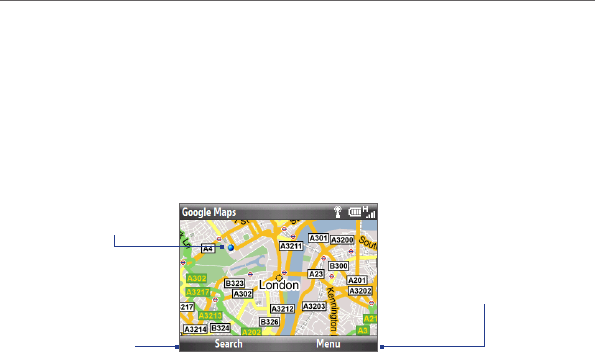
Chapter 9
Navigating on the Road
9.1 Using Google™ Maps (Available by Country)
Google™ Maps lets you track your current location, view real-time traffic situations,
and receive detailed directions to your destination. It also provides a search tool
where you can locate places of interest or an address on a vector or a satellite map.
Note You need an active data connection or Wi-Fi connection to use Google Maps.
Opening Google Maps
Click Start > Google Maps, and then read and agree to the terms and conditions.
Click to search for places of
interest and addresses.
Click to open a menu where you
can view your current location, get
directions, see traffic information,
and more.
Click Menu > Help > Tips to learn
more about Google Maps.
Your current
location.
Notes • Currently, traffic information is only available for the U.S.
• Click Menu > Options > Reset Google Maps to reset the Google Map cookies,
history of search terms, preferences, and image cache.

118 Navigating on the Road
Searching for places of interest
You can search and locate a place of interest using Google Maps. Google Maps also
shows the contact information and gives directions on how to get to the place of
interest from your current location.
Note You can also search for keywords, addresses, and postal codes.
On the Google Maps screen, click Search.
Enter the place of interest you want to go to (for example, museum of
modern art), and then click Search.
In the search results list, click an item to view its contact information.
4. On the Address tab, click:
The web address (when available) to open the web site of the place of
interest.
The [phone number] to call the place of interest that you have selected.
Directions to here or Directions from here to get directions on how to
get to the place of interest from your current location or how to get to
another location from the place of interest.
Send as text message to send the location’s contact information to a
contact via SMS.
Search nearby to search for other places of interest near the current place
of interest.
For more information about Google Maps, go to: http://www.google.com/gmm/
index.html.
1.
2.
3.
•
•
•
•
•
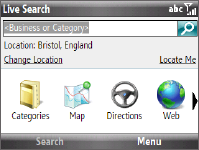
Navigating on the Road 119
9.2 Using Windows Live™ Search
Windows Live™ Search offers you a fast and easy way to find and view maps
and local information on your phone. With Windows Live™ Search, you can locate
nearby restaurants, shopping centers, check for street addresses and phone
numbers, view maps with directions to and from a location, and more.
To open Windows Live Search
Click Start > Live Search.
Read the Service Agreement, and then click Accept.
On the Welcome screen click OK.
Note You may be prompted to install an update for Live Search. Click Yes to install the
update.
The Live Search main window appears.
To nd a location
Specify first the location of the place that you want to search. You can begin
by selecting from the list of cities. You can also select Change Location to
enter a city, select on a map, or get a contact’s address.
Enter the location that you want to find and then press the TRACKBALL.
The Search Results screen then shows a list of matched places. Use the
TRACKBALL to browse through the list. As you browse, the address, phone
number, and estimated distance of a selected item are displayed.
1.
2.
3.
1.
2.
3.
120 Navigating on the Road
Select the desired location in the Search Results screen.
On the Details screen:
Click Map to see the location on a map.
Select Directions to Here for instructions on how to reach the location.
Select Search Near Here to nd addresses, businesses, or other places of
interest near the location.
Note If you connect a Bluetooth GPS receiver and set it up on your phone, Live Search can
track your current position. You can use your current position as a starting point for
finding a desired location. See the user manual of your GPS device for more details.
9.3 Guidelines and Preparation for Using GPS
If you install a GPS software on your phone, please follow these guidelines before
and when using your phone as a GPS device.
When using GPS navigation software in the car, always plot your GPS route
before starting to drive. Do not try to configure the GPS navigation software
while driving.
The plotted GPS route is only for driving reference. It should not interfere with
actual driving behavior.
Do not leave your phone in a vehicle or expose the phone to direct sunlight
to avoid overheating the battery, which could cause damage to the phone or
pose a risk to the vehicle.
When using the phone inside a vehicle, use the car holder to mount the
phone securely in place. Avoid placing the phone in the areas shown in the
following diagram:
4.
5.
•
•
•
•
•
•
•
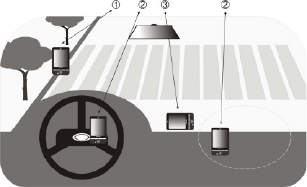
Navigating on the Road 121
1 Do not place where it will
block the driver’s vision.
2 Do not place where air bags
could deploy.
3 Do not place anywhere in the
vehicle without securing the
phone in the holder.
Use the GPS system cautiously. Users shall be liable for any damages resulting
from negligent operation of the system.
The GPS signal cannot pass through solid non-transparent objects. Signal
reception may be affected by obstructions such as high-rise buildings,
tunnels, bridges, forests, weather (rainy or cloudy days), etc. If the vehicle’s
visor contains metal, it will be difficult for the GPS signal to pass through.
Other nearby wireless communication products (such as mobile phones or
radar-detecting devices) may interfere with the satellite signal, resulting in
unstable signal reception.
The Global Positioning System (GPS) is built and operated by the US
Defense Department. The Department is responsible for the accuracy and
maintenance of the system. Any changes that the Department makes may
affect the accuracy and function of the GPS system.
9.4 Downloading Satellite Data via QuickGPS
Before using the phone for GPS navigation, open QuickGPS to download
ephemeris data (current satellite position and timing information). QuickGPS
significantly speeds up the time for determining your GPS position. QuickGPS
downloads ephemeris data from web servers, instead of from satellites, using your
phone’s Internet connection via Wi-Fi, ActiveSync or GPRS/3G.
•
•
•
•
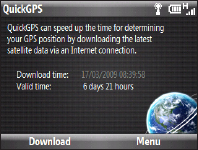
122 Navigating on the Road
To open QuickGPS
Click Start > Accessories > QuickGPS.
To download GPS data
Click Download on the QuickGPS screen.
On the screen, initially, you will see the Valid
time of the downloaded data. As time passes, the
remaining days and hours of validity will be shown.
To speed up GPS positioning, download the latest
ephemeris data when the validity of the data
expires.
Changing the download options
To configure download options, click Menu > Options and choose from available
options:
• Remind me when data expires.
Display a message when ephemeris data expires.
• Auto download when data expires.
Automatically download ephemeris data when it expires.
• Auto download when connected to PC via ActiveSync.
Automatically download ephemeris data when it is connected to your
computer via ActiveSync. Your computer must be connected to the Internet
to download ephemeris data.
• Exit QuickGPS after downloading.
Close QuickGPS after satellite data is downloaded.

Chapter 10
Camera and Multimedia
10.1 Taking Photos and Videos
Capturing photos and recording video clips are easy with your phone’s built-in
megapixel camera.
To open Camera
Press , or on the Homescreen, click Start > Multimedia > Camera or
Video Recorder.
To choose where to save your photos and videos
If you installed a microSD card, you will be prompted to choose whether to save
your pictures and videos on the Main Memory or on Storage Card. Select the
location, press the TRACKBALL, and then click OK.
To close the Camera
Press the END CALL/POWER button.
Note Pressing END CALL/POWER simply minimizes the Camera program, but it is still
running in the background. To completely close the Camera program, use the Task
Manager.
Capturing photos and video clips
Aim the camera at the subject and then press the TRACKBALL to take the shot.
When capturing video, press the TRACKBALL to start recording; press it again to
stop.
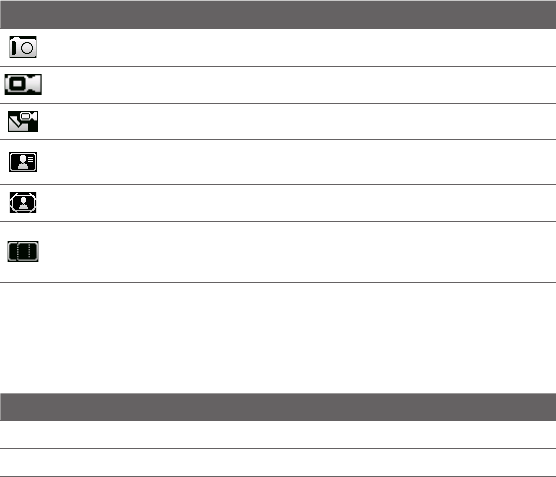
124 Camera and Multimedia
Capture modes
The Camera program lets you capture pictures and video clips by using various
built-in modes. The title bar displays the active capture mode.
The available capture modes are as follows:
Icon Capture mode Function
Photo Captures standard still images.
Video Captures video clips, with or without audio.
MMS Video Captures video clips suitable for sending via MMS.
Contacts Picture Captures a still image suitable for assigning as an identification
photo to a contact.
Picture Theme Captures still images and places them within frames.
Panorama
Captures a sequence of still images continuously in one direction,
and stitches the images together to create a panoramic view of
a scenery.
To change the capture mode
On the Camera screen, scroll right or left with the TRACKBALL to change the
capture mode.
Using the above capture modes, the camera captures files in the following formats:
Capture mode Format
Photo / Contacts Picture / Picture Theme / Panorama JPEG
Video / MMS Video MPEG-4 (.mp4); H.263 baseline (.3gp)
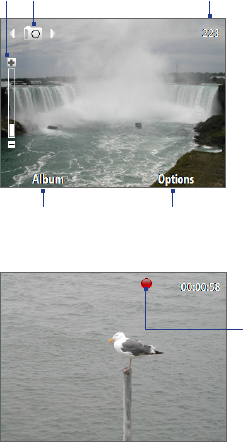
Camera and Multimedia 125
Camera screen icons and indicators
The icons and indicators disappear after a few seconds when there is no user
interaction. Roll the TRACKBALL, press any key on the keyboard, or press the LEFT/
RIGHT SOFT KEYS to display the icon indicators again.
Camera screen (in Photo mode)
1 Indicates the current zoom ratio. Scroll up
or down to increase or decrease the zoom
level.
2 Indicates the current capture mode.
3 Depending on the capture mode, this
shows the remaining available number of
pictures that you can take or remaining
duration that can be recorded. While
recording video, this shows the recorded
duration.
4 Click to open the Camera settings menu.
5 Click to open Album.
321
45
Camera screen (in Video mode)
6 The Recording Status indicator blinks
while video recording is in progress.
6
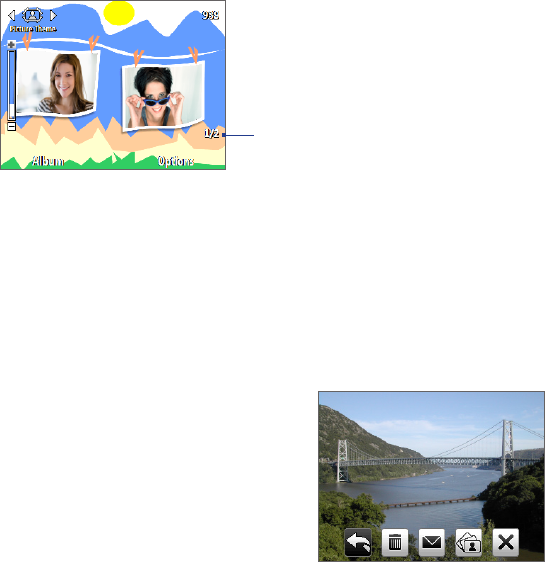
126 Camera and Multimedia
Camera screen (Picture Theme mode)
7
7 Displays the current and total number
of photos that can be taken using the
selected template.
Using zoom
Before capturing a still image or a video clip, you can first zoom in to make the
object in focus move closer, and you can zoom out to make the object move farther
away. In all capture modes, roll the TRACKBALL up to zoom in and roll it down to
zoom out.
The camera zoom range for a picture or video depends on the capture mode and
capture size. Take note that the capture sizes available for certain capture formats
also vary from one capture mode to another.
The Review screen
After capturing a photo or video, you will be
presented with options that you can do with
the captured file.
Use the TRACKBALL to navigate through the
review screen buttons.
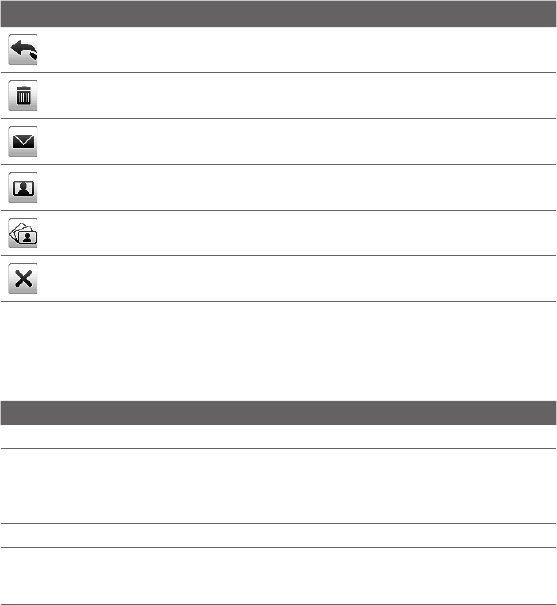
Camera and Multimedia 127
Press To
Go back to the Camera screen.
Delete the captured media.
Send the captured image or video clip to someone via email or MMS.
Associate the photo to a selected contact.
View the image in Album or play back the video in Windows Media Player.
Hide the Review screen icons. Click again to show the icons.
Customizing the advanced settings
On the Camera screen, click Options to open the Camera Advanced settings where
you can activate the self-timer, change the ambience, customize capture settings,
and more. Use the TRACKBALL to go through the available settings.
Option Allows you to
Mode Select the capture mode to use.
Self-timer Select the Self-timer option for capturing images: Off, 2
seconds, or 10 seconds. Selecting 2 seconds or 10 seconds
delays the capturing by the specified time after you press the
TRACKBALL.
Brightness Adjust the brightness from -2 to +2 (increments of 0.5).
White Balance
Specify the white balance setting such as Auto, Daylight,
Night, Incandescent, and Fluorescent to suit the lighting
environment.

128 Camera and Multimedia
Option Allows you to
Resolution Choose the resolution to use. The resolution options depend
upon which camera mode you are using.
Capture Format
(Video and MMS Video
modes only)
Select whether to use MPEG4 or H.263.
Template
(Picture Theme mode only)
Choose one of the four templates to use for Picture Theme
mode.
Quality Select the JPEG image quality level for all captured still images.
You can choose from Basic, Normal, Fine, and Super Fine. This
option is available in all modes except Video and MMS Video.
Time Stamp
(Photo mode only)
Choose whether or not to include the shooting date and time
on captured photos.
Storage Select where you want to save your files. You can either save the
files to the main memory or to a storage card.
Template
(Picture Theme mode only)
Select the template to use.
Direction
(Panorama mode only)
Choose in what direction images will be stitched in a panorama.
Stitch Count
(Panorama mode only)
Select the desired number of snapshots to be taken and
stitched into a panorama.
Keep Backlight Choose whether to turn the backlight on or off while using the
camera. This overrides your phone backlight settings while you
are using the camera.
Shutter Sound Choose whether or not you want the camera to make a shutter
sound when you take photos or record video clips.

Camera and Multimedia 129
Option Allows you to
Review Duration Set a time length for displaying the captured image or video on
the Review screen before automatically saving it and returning
to the live Camera screen. Select No Limit to allow the picture
to be displayed until you choose to take another action. Select
No Review to immediately return to the live Camera screen
after capturing.
Effect Choose a special effect such as Grayscale, Sepia, or Negative
to apply to your photos or video clips. Note that White Balance
cannot be applied if you already applied an effect to the photo.
Metering Mode Select a metering mode to allow the camera to measure
the amount of light in the center and around the image and
calculate the best-fit exposure value before capturing. Choose
either Center Area to measure light using the center area of the
image or Average to measure light using the area all around
the image.
Record with Audio
(Video and MMS Video
modes only)
Select On to record audio while capturing video clips. This is
selected On by default. If you select Off and then capture a
video clip, it will have no audio.
Prefix Set a prefix to image or video filenames. When Default is
selected as the prefix, the filename of each new captured file
is set to “IMAGE” or “VIDEO” followed by a sequential number,
for example: IMAGE_001.jpg. You may also choose to prefix
filenames using either the current Date or Date & Time.
Note: If you set the Camera to save captured photos to a
storage card, the prefix cannot be selected. Captured photos
will be named using the DCIM (Digital Camera Images) naming
standard.
Counter Select Reset to reset the naming counter to 1.

130 Camera and Multimedia
Option Allows you to
Flicker Adjustment When taking indoor shots, flicker on the camera screen may
be caused by interference from fluorescent lighting. To reduce
flicker, change the flicker adjustment setting to Auto or to the
proper frequency (50Hz or 60Hz) of the country where your
phone is being used.
Template Folder
(Picture Theme mode only)
By default, templates are stored in the \My Documents\
Templates folder on the phone’s main memory. If you
transferred some templates to a storage card (using File
Explorer), set this option to Main + Card to specify that
templates are located in both the main memory and the
storage card.
Show Reminder
(Contacts Picture mode
only)
Select On to be prompted to set the picture to a contact after
taking a contact picture. Select Off to disable the prompt.
Recording Limit Specify the maximum time or file size for recording video clips.
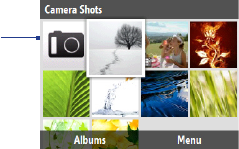
Camera and Multimedia 131
10.2 Using Album
View images and videos that you captured using the Camera program in Album.
Album offers a host of features that let you rotate images, view your images as a
slide show, use images as contact pictures, and more.
Note Album can only display files using the JPEG, MPEG4 or H.263 file formats.
To open Album
Click Start > Multimedia > Album, or click Album while in the Camera screen.
Click to go to the
Camera program
To view an image in full screen
On the Album screen, use the TRACKBALL to select the image you want to view and
then press the TRACKBALL. While viewing the image, click Zoom In to zoom in on
the image.
Note If you do not see Zoom In on the screen, press the TRACKBALL to show the menu bar
at the bottom of the screen.
While zoomed in, use the TRACKBALL to pan the image. Click Zoom Out to zoom
out of the image.
To go to the next image
Roll the TRACKBALL left or right to go to the next or previous image.
Note If you are zoomed in on an image, you need to zoom out first before you can go to the
next or previous image.
132 Camera and Multimedia
To view the images as a slide show
On the Album screen, select the image where you want to start the slideshow from
and then click Menu > Slide Show. The slideshow automatically starts playing back
from the selected image.
Tips • Press the TRACKBALL to pause the slideshow playback. Press the TRACKBALL again
to resume playback.
• On the Album screen, click Menu > Options to set slide show options such as
transition to use and duration of each image.
To play back video les
On the Album screen, click the thumbnail of the video file you want to play.
Windows Media Player then plays back the file.
10.3 Using Pictures & Videos
Pictures & Videos allows you to view and manage media files on your phone.
To copy a picture or video clip to your phone
You can copy pictures and video files from your PC to the My Pictures folder on your
phone, and then view them on your phone. For more information about copying
files from your PC to your phone, see Windows Mobile Device Center or ActiveSync
Help on your PC.
Note You can also copy pictures and video files from your PC to your phone using a storage
card. Install the storage card to your phone, and then copy them from your PC to the
folder you created on the storage card.
To view media les
On the Home screen, click Start > Multimedia > Pictures & Videos.
Select a media file and click View or Play (if video file) to view or play back
the file.
1.
2.
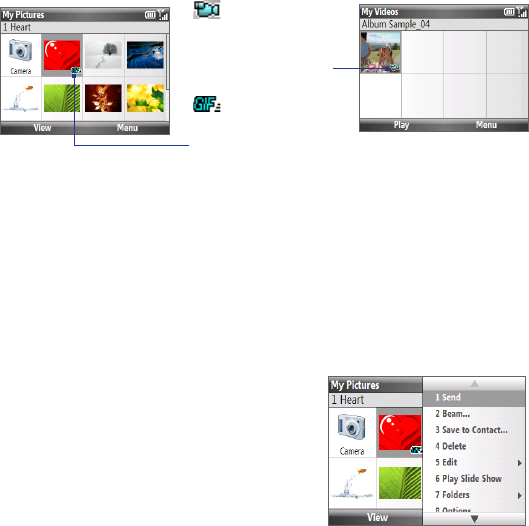
Camera and Multimedia 133
Indicates that the
file is a GIF animation
file. Click View to play
back the file.
Indicates that the
file is a video file. Click
Play to play back the
file in Windows Media
Player Mobile.
Note If you cannot find the media file in the default My Pictures folder, click
Menu > Folders > My Device to go to other folders.
Pictures & Videos menu
Select a media file onscreen and click Menu to open a list of options that you can
do with the selected media file.
You can choose to send the selected media file via one of your messaging accounts,
beam it to another device, play the pictures as a slide show, send the picture to
your Windows Live MySpace account, and more.
Click Options to customize picture settings and
slide show playback preferences.
Note The available menu options depend on the
selected media file.
Tip When viewing a picture, click Menu > Use as
Home Screen to set the picture as your Home
screen background. You can also click Menu >
Edit to do minor edits to the photo.

134 Camera and Multimedia
10.4 Using Windows Media Player Mobile
You can use Microsoft® Windows Media® Player Mobile for Smartphone to play
digital audio and video files that are stored on your phone or on a network, such as
on a Web site.
To open Windows Media Player Mobile, click Start > Multimedia >
Windows Media.
About the screens and menus
Windows Media Player Mobile has three primary screens:
Library screen
The screen that lets you
quickly find your audio
files, video files, and
playlists.
Now Playing screen
This special playlist
indicates the current file
being played and files that
are queued up to play next.
Playback screen
The default screen that
displays the playback
controls and the video
window.
Click Menu to open a list of options that you can do in a particular screen The
commands on this menu vary, depending upon which screen you are viewing.
Playing media
To play media on your phone
Use the library to find and play songs, videos, and playlists that are stored on your
phone or storage card.
If you are not on the Library screen, click Menu > Library.
If necessary, on the Library screen, click Menu > Library, and then select the
library that you want to use.
1.
2.
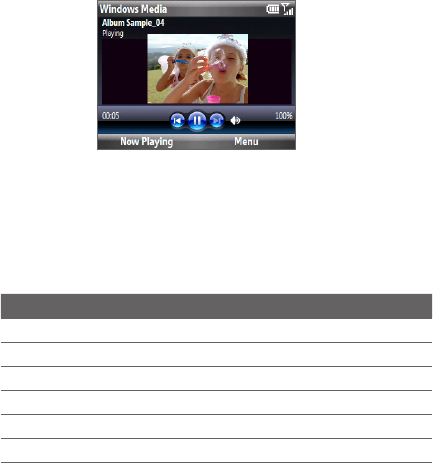
Camera and Multimedia 135
Windows Media Player Mobile automatically updates the library. However,
you can manually update the library to ensure that it contains new files that
you recently copied to your phone or storage card. Click Menu > Update
Library to manually update the library list.
Select a category (for example, My Music or My Playlists), select the item
that you want to play (such as a song, album, or artist name), and then click
Play. The Playback screen opens.
Note To play a file that is stored on your phone but is not in a library, on the Library screen,
click Menu > Open File. Select the item that you want to play (such as a file or a
folder), and click Play.
Playback controls
By default, these hardware buttons are assigned to Windows Media Player Mobile
functions.
To Press
Play or pause the TRACKBALL
Skip to a previous file Roll the TRACKBALL left
Skip to the next file Roll the TRACKBALL right
Increase the volume Roll the TRACKBALL up
Decrease the volume Roll the TRACKBALL down
Turn the sound on or off quickly (mute) #
3.
4.

136 Camera and Multimedia
To Press
Switch to full screen during video playback
0
Change rating *
Tip To change the assigned hardware buttons, on the Playback screen, click Menu >
Options > Buttons.
Copying files to your phone
Use the Sync feature in Windows Media Player on your PC to synchronize (copy)
digital media files from your PC to your phone. Using Sync ensures that protected
files and album art (for skins) are copied to your phone correctly.
To synchronize content to your phone automatically
On your PC, start Windows Media Player and then connect your phone to
your PC.
In the Device Setup Wizard, type a name for the phone and click Finish.
On the leftmost pane, right-click your phone and select Set Up Sync.
On the Device Setup dialog box, select the Sync this device automatically and
then select the playlist(s) that you want to sync between the PC and your phone.
Click Finish.
Note You can also sync your storage card if you have one installed on your phone.
To sync, right-click Storage Card.
The files begin synchronizing to your phone. The next time you connect your
phone to your PC while Windows Media Player is running, synchronization will start
automatically.
To synchronize and copy content manually to your phone
If you have not set up synchronization between your phone and PC, follow
steps 1 to 3 in “To synchronize content to your phone automatically.”
Click the Sync tab on the Windows Media Player. Select a Playlist or a Library
on the left panel of the Windows Media Player.
1.
2.
3.
4.
5.
1.
2.
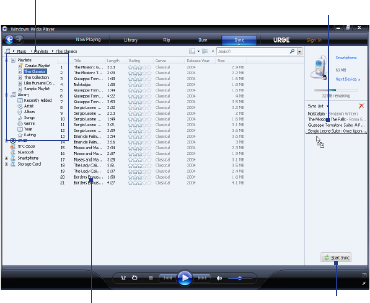
Camera and Multimedia 137
From the content list, drag files you want to sync to your phone to the right
panel of the Windows Media Player.
Click Start Sync to start copying files to your phone.
Playlists and Library list
Start SyncPlaylist or library content list
Drag files from the content
list to sync to your phone
Notes • Always use Windows Media Player 11 on your PC to synchronize (copy) files to your
phone.
• Audio files copy faster if Windows Media Player is configured to automatically set
the quality level for audio files copied to your phone. For more information, see the
Windows Media Player Help.
Troubleshooting
For more information, visit: http://www.microsoft.com/windowsmobile/en-us/help/
more/windows-media-player.mspx.
3.
4.

138 Camera and Multimedia
10.5 Using Streaming Media
Streaming Media lets you stream live broadcasts or on-demand media content
from the web. The media is sent in a continuous stream to your phone and is played
as it arrives, along with the audio.
The Streaming Media program allows you to play 3GP and MPEG-4 files. It also
supports playback of SDP (Session Description Protocol) files.
To access streaming content via Internet Explorer
In Internet Explorer, you can open a Web page containing http links to streaming
media content and play the content in the Streaming Media program.
On the Home screen, click Start > Internet Explorer.
Click Menu > Go to Web Address. In the address bar, enter the URL address
of the Web page that contains the http link to the desired *.3gp, *.mp4, or
*.sdp file.
On the Web page, select the RTSP link and press the TRACKBALL.
Streaming Media opens and starts playing the file. During playback, use the
control buttons to play/pause the video or view in full screen mode. Use the
volume keys on the side of the device to adjust the audio volume.
Do this To
Press the TRACKBALL Play or pause playback.
Roll the TRACKBALL left Rewind
Roll the TRACKBALL right Fast forward
Press the LEFT SOFT KEY Play the video in full screen.
While watching in full screen,
press the BACK key ( ) to
return to normal viewing mode.
1.
2.
3.
4.
Camera and Multimedia 139
To view streaming video le information
Click Menu > Properties to view the properties and general information of a
streaming video clip, such as file format, audio codec, dimension, frames, and
duration of the video.
To congure streaming video connection settings
Click Menu > Options to configure the following settings:
Playback. Specify the media buffer (in terms of duration) to allot for storing
video and audio data while streaming media.
Networks. Choose whether you want to connect to the Internet or corporate
network (intranet) to locate a streaming video clip. Specify also a range of
port numbers to use for streaming.
Video. Start with full screen, or with video adjusted to best fit.
•
•
•
140 Camera and Multimedia

Chapter 11
Using Other Applications
11.1 Microsoft® Office Mobile
Microsoft® Office Mobile consists of three applications that let you view and edit
Microsoft documents. These three applications are:
• Microsoft® Oce Excel® Mobile lets you create and edit Excel workbooks
and templates on your device.
• Microsoft® Oce OneNote® Mobile lets you create notes with text,
photos, and voice recordings for synchronization later with Microsoft®
Oce OneNote® 2007 on your computer.
• Microsoft® Oce PowerPoint® Mobile allows you to view (not create)
slide show presentations in *.ppt and *.pps formats.
• Microsoft® Oce Word Mobile lets you create and edit documents and
templates in Word Mobile and save them as *.doc, *.rtf, *.txt, and *.dot
les.
To learn how to copy files, see “Copying and Managing Files” in Chapter 4.
To use Microsoft Oce Mobile
Click Start > Office Mobile.
Click the Office Mobile application that you want to use.
Word Mobile and Excel Mobile do not fully support some features of Microsoft®
Office Word and Microsoft® Office Excel®. To see a complete list of features that are
not supported in Word Mobile and Excel Mobile, see Help on your device.
1.
2.
142 Using Other Applications
Tips • By default, Word Mobile saves documents in .docx format, while Excel Mobile
saves workbooks in .xlsx format. If you want to open these types of files on
a computer that uses Microsoft Office 2000, Office XP, or Office 2003, you
need to download and install the File Format Converter in your computer.
You can find this converter at http://www.microsoft.com/downloads/details.
aspx?FamilyId=941B3470-3AE9-4AEE-8F43-C6BB74CD1466&displaylang=en.
• If you want Word Mobile to save documents in .doc format, click Menu >
Tools > Options (or Menu > Options when no document is opened), then change
the Default template to Word 97-2003 Document (.doc).
• If you want Excel Mobile to save workbooks in a format that is compatible with
Microsoft Office 2000, Office XP, or Office 2003, click Menu > Options (with no
workbook opened), then change the Template for new workbook to Blank 97-
2003 Workbook.
11.2 Adobe® Reader® LE
Adobe® Reader® LE lets you view Portable Document Format (PDF) files.
When you open a password-protected PDF file, you will be prompted to enter the
password before the file can be opened.
To open a PDF le on your phone
Click Start > Accessories > Adobe Reader LE.
Click Open.
Browse to a folder and click the PDF file you want to open.
Note To open another PDF file, click Menu > Open > Browse For File. You can also open a
PDF file from File Explorer by clicking it.
1.
2.
3.
Using Other Applications 143
To navigate through a PDF le
You can do any of the following:
Use the TRACKBALL to scroll through the pages.
Click Tools > Go To and select an option to go to a specific page in the PDF file.
Click Tools > Zoom to zoom in and out on the document.
11.3 JBlend
Use JBlend to download, install and manage MIDlets or MIDlet suites on your
device. MIDlets are Java applications such as games and tools that can run on
mobile devices, while a MIDlet suite is a collection of one or more MIDlets. Your
device supports Java 2 Micro Edition (J2ME).
To open JBlend
Click Start > Accessories > JBlend.
Installing and running MIDlets/MIDlet suites
To download and install from the Internet
Open Internet Explorer.
Navigate to the web page with the link for the MIDlet/MIDlet suite you want
to download, and click the link.
Follow the onscreen instructions to install and run the MIDlet/MIDlet suite.
Notes • You can cancel the installation at any time.
• Downloaded MIDlets will be automatically saved in the My Documents folder.
To install from a PC
You can install the MIDlets/MIDlet suites on your phone from a PC using the USB
sync cable, or Bluetooth. MIDlets copied to your phone using Bluetooth or email
attachments are automatically saved in the My Documents folder.
•
•
•
1.
2.
3.
144 Using Other Applications
To install from your device
On the JBlend screen, click Install > Local Install. The program then searches
for MIDlets/MIDlet suites on your device and displays them in a list.
From the list, select the MIDlet/MIDlet suite that you want to install and press
The TRACKBALL.
Follow the onscreen instructions to install and run the MIDlet/MIDlet suite.
To run MIDlets/MIDlet suites on your phone
On the JBlend screen, open the folder that contains the MIDlet/MIDlet suite, and
then click the MIDlet/MIDlet suite.
Managing MIDlets/MIDlet suites
You can organize the MIDlets/MIDlet suites into folders. You can also uninstall,
move or rename MIDlets/MIDlet suites.
To update a MIDlet/MIDlet suite
On the JBlend screen, select the MIDlet/MIDlet suite that you want to update.
Click Menu > Application > Update Info. JBlend then searches for updates
for the selected MIDlet/MIDlet suite.
To uninstall a MIDlet
Before you uninstall a MIDlet/MIDlet suite, make sure that it is not running.
On the JBlend screen, select the MIDlet/MIDlet suite that you want to remove.
Click Menu > Application > Delete.
Click Yes to confirm.
Note To uninstall all MIDlets and folders, click Menu > Application > Delete All.
1.
2.
3.
1.
2.
1.
2.
3.

Using Other Applications 145
11.4 Voice Command
Voice Command lets you call your contacts, open applications, play back music,
and get calendar information just by using your voice. Voice Command only
responds to a set of predefined commands. You cannot create your custom
commands in Voice Command.
When not in a call, press and hold the TALK/SEND button to activate Voice
Command. When Voice Command is activated, the Voice Command icon ( ) will
appear at the upper-right corner of the screen.
To call a contact
Hold the phone a few inches away from your mouth.
Press and hold TALK/SEND to activate Voice Command.
In a clear voice, say “Call [Contact Name].”
Voice Command will confirm with you the contact you want to call.
After the Voice Command confirmation, say “Yes” or “Correct.”
Note If Voice Command is wrong about the contact to call, say “No” or “Incorrect” to try
again.
5. The phone calls the contact.
To show the contact card of a contact
This will only show contacts that are saved on the phone.
Hold the phone a few inches away from your mouth.
Press and hold TALK/SEND to activate Voice Command.
In a clear voice, say “Show [Contact Name]” or “Lookup [Contact Name].”
To request information from your calendar
1. Hold the phone a few inches away from your mouth.
2. Press and hold TALK/SEND to activate Voice Command.
3. In a clear voice, say the information you want to retrieve.
1.
2.
3.
4.
1.
2.
3.
146 Using Other Applications
For example, “What’s my next appointment?” or “What’s my next meeting?”
Consult the Voice Command help file to learn the other commands that you can
use to retrieve other Calendar information.
To open a program
Hold the phone a few inches away from your mouth.
Press and hold TALK/SEND to activate Voice Command.
In a clear voice, say “Open [Program Name].”
Tip You can also say “Show [Program Name]” or “Start [Program Name]” to open programs.
Use the phrase that you are most comfortable with.
To request phone status information
Hold the phone a few inches away from your mouth.
Press and hold TALK/SEND to activate Voice Command.
In a clear voice, say the phone status information you want to retrieve. For
example, say “What time is it?” or “What date is it?”
To use Voice Command with a Bluetooth headset
Activate Voice Command from your Bluetooth headset by pressing the voice dial
button on the Bluetooth headset, if available.
To get help in using Voice Command
Hold the phone a few inches away from your mouth.
Press and hold TALK/SEND to activate Voice Command.
In a clear voice, say “Help.”
You can also select Start > Voice Command and then select Menu > Help to access
the Voice Command Help, or visit the following web site for more information:
http://www.microsoft.com/windowsmobile/voicecommand/default.mspx.
1.
2.
3.
1.
2.
3.
1.
2.
3.

Appendix
A.1 Specifications
System information
Processor Qualcomm® MSM7225™, 528MHz
Operating system Windows Mobile® 6.1 Standard
Memory ROM: 256 MB
RAM: 192 MB SDRAM
Dimensions (LxWxT) 116.5 x 61.5 x 12.0 mm ( 4.59 x 2.42 x 0.47 inches)
Weight 120 grams (4.23 ounces) with battery
Display 2.4 inch TFT-LCD with QVGA resolution
Network HSDPA/WCDMA
850/1900 MHz
Up to 7.2 Mbps download speeds
Quad-band GSM/GPRS/EDGE
850/900/1800/1900 MHz
(Band frequency and data speed are operator dependent.)
Device Control Trackball with Enter button
Keyboard 4-row QWERTY keyboard
GPS Internal GPS antenna
Connectivity Bluetooth® 2.0 with Enhanced Data Rate and A2DP for stereo
wireless headsets
Wi-Fi®: IEEE 802.11 b/g
HTC ExtUSB™ (11-pin mini-USB 2.0 and audio jack in one)
Camera 2.0 megapixel color camera with fixed focus

148 Appendix
Audio Supported
Formats
AAC, AAC+, eAAC+, AMR, AWB, QCP, MP3, WMA, WAV, MIDI
Video Supported
Formats
WMV, ASF, MP4, 3GP, 3G2, M4V, AVI (Motion JPEG only)
Battery Rechargeable Lithium-ion battery
Capacity: 1500 mAh
Standby time:
Up to 480 hours for WCDMA
Up to 380 hours for GSM
Talk time:
Up to 300 minutes for WCDMA
Up to 510 minutes for GSM
(The above are subject to network and phone usage.)
Expansion Slot microSD™ memory card (SD 2.0 compatible)
AC Adapter AC input: 100 ~ 240V AC, 50/60 Hz
DC output: 5V and 1A
Special Features Inner Circle™
Note: Specifications are subject to change without prior notice.
A.2 Regulatory Notices
Regulatory Agency Identifications
For regulatory identification purposes, your product is assigned a model number of
MAPL120.
To ensure continued reliable and safe operation of your device, use only the
accessories listed below with your MAPL120.
The Battery Pack has been assigned a model number of RHOD160.
This product is intended for use with a certified Class 2 power supply unit, rated 5
Volts DC, maximum 1 Amp.
Appendix 149
Federal Communications Commission Notice
This device complies with part 15 of the FCC Rules. Operation is subject to the
following two conditions: (1) This device may not cause harmful interference, and
(2) this device must accept any interference received, including interference that
may cause undesired operation.
This equipment has been tested and found to comply with the limits for a Class
B digital device, pursuant to Part 15 of the FCC Rules. These limits are designed
to provide reasonable protection against harmful interference in a residential
installation. This equipment generates, uses, and can radiate radio frequency
energy and, if not installed and used in accordance with the instructions, may
cause harmful interference to radio communications. However, there is no
guarantee that interference will not occur in a particular installation. If this
equipment does cause harm-ful interference to radio or TV reception, which can
be determined by turning the equipment on and off, the user is encouraged to try
to correct the interference by one or more of the following measures:
Reorient or relocate the receiving antenna.
Increase the separation between the equipment and receiver.
Connect the equipment into an outlet on a circuit different from that to
which the receiver is connected.
Consult the dealer or an experienced radio or television technician for help.
Modifications
The FCC requires the user to be notified that any changes or modifications made
to the device that are not expressly approved by High Tech Computer Corporation
may void the user’s authority to operate the equipment.
Body-worn operation
This device was tested for typical body-worn operations with the back of the
phone kept 1.5cm from the body. To maintain compliance with FCC RF exposure
requirements, use only belt-clips, holsters or similar accessories that maintain a
1.5cm separation distance between the user’s body and the back of the phone,
including the antenna.
•
•
•
•
150 Appendix
The use of belt-clips, holsters and similar accessories should not contain metallic
components in its assembly. The use of accessories that do not satisfy these
requirements may not comply with FCC RF exposure requirements, and should be
avoided.
Safety Precautions for Radio Frequency Exposure
Use only original manufacturer-approved accessories, or accessories that do not
contain any metal.
Use of non-original manufacturer-approved accessories may violate your local
Radio Frequency exposure guidelines and should be avoided.
FCC RF Radiation Exposure Statement
This Transmitter has been demonstrated co-location compliance
requirements with Bluetooth and WLAN.
This transmitter must not be co-located or operating in conjunction with any
other antenna or transmitter.
This equipment complies with FCC RF radiation exposure limits set forth for
an uncontrolled environment.
Exposure to Radio Frequency (RF) Signals
Your phone contains a radio transmitter and receiver. The radiated output power
is far below the international radio frequency exposure limits. These limits are part
of comprehensive guidelines and establish permitted levels of Radio Frequency
energy for the general population. The guidelines are based on the safety
standards previously set by international standards bodies:
American National Standards Institute (ANSI) IEEE. C95.1-1992
National Council on Radiation Protection and Measurement (NCRP).
Report 86. 1986
International Commission on Non-Ionising Radiation Protection (ICNIRP) 1996
Ministry of Health (Canada), Safety Code 6. The standards include a
substantial safety margin designed to assure the safety of all persons,
regardless of age and health.
•
•
•
•
•
•
Appendix 151
The exposure standard for wireless mobile phones employs a unit of measurement
known as the Specific Absorption Rate, or SAR. The standard incorporates a
substantial margin of safety to give additional protection for the public and to
account for any variations in usage.
As with other mobile radio transmitting equipment, users are advised that for
satisfactory operation of the equipment and for the safety of personnel, it is
recommended that no part of the human body be allowed to come too close to
the antenna during operation of the equipment.
Your phone has an internal antenna. Use only the supplied integral antenna. Use
of unauthorized or modified antennas may impair call quality and damage your
phone, causing loss of performance and SAR levels exceeding the recommended
limits as well as result in non-compliance with local regulatory requirements in
your country.
To assure optimal phone performance and ensure human exposure to Radio
Frequency energy is within the guidelines set forth in the relevant standards;
always use your phone only in its normal-use position. Do not touch or hold the
antenna area unnecessarily when placing or receiving a phone call. Contact with
the antenna area may impair call quality and cause your phone to operate at a
higher power level than needed. Avoiding contact with the antenna area when
your phone is IN USE optimizes the antenna performance and the battery life.
Tests for SAR are conducted using standard operating positions specified by
the FCC with the phone transmitting at its highest certified power level in all
tested frequency bands. Although the SAR is determined at the highest certified
power level, the actual SAR level of the phone while operation can be well
below the maximum value. This is because the phone is designed to operate at
multiple power levels so as to use only the power required to reach the network.
In general, the closer you are to a wireless base station antenna, the lower the
power output. Before a phone model is available for sale to the public, it must be
tested and certified to the FCC that it does not exceed the limit established by the
government-adopted requirement for safe exposure. The tests are performed in
positions and locations (for example, at the ear and worn on the body) as required
by the FCC for each model.
152 Appendix
(Bodyworn measurements may differ among phone models, depending upon
available accessories and FCC requirements). For body worn operation, to maintain
compliance with FCC RF exposure guidelines, use only original manufacturer
approved accessories. When carrying the phone while it is on, use the specific
original manufacturer supplied or approved carrying case, holster, or other body-
worn accessory.
SAR Information
0.697 W/Kg @1g (Body)
1.26 W/Kg @1g (Head)
Telecommunications & Internet Association (TIA) safety
information
Pacemakers
The Health Industry Manufacturers Association recommends that a minimum
separation of six inches be maintained between a handheld wireless phone
and a pacemaker to avoid potential interference with the pacemaker. These
recommendations are consistent with the independent research by and
recommendations of Wireless Technology Research. Persons with pacemakers:
• Should ALWAYS keep the phone more than six inches from their pacemaker
when the phone is turned ON.
• Should not carry the phone in a breast pocket.
• Should use the ear opposite the pacemaker to minimize the potential for
interference. If you have any reason to suspect that interference is taking
place, turn your phone OFF immediately.
Hearing Aids
Some digital wireless phones may interfere with some hearing aids. In the event
of such interference, you may want to consult your service provider, or call the
customer service line to discuss alternatives.

Appendix 153
Other Medical Devices
If you use any other personal medical device, consult the manufacturer of your
device to determine if they are adequately shielded from external RF energy. Your
physician may be able to assist you in obtaining this information.
Turn your phone OFF in health care facilities when any regulations posted in
these areas instruct you to do so. Hospitals or health care facilities may be using
equipment that could be sensitive to external RF energy.
WEEE Notice
The Directive on Waste Electrical and Electronic Equipment (WEEE), which entered
into force as European law on 13th February 2003, resulted in a major change in the
treatment of electrical equipment at end-of-life.
The purpose of this Directive is, as a first priority, the prevention of WEEE, and
in addition, to promote the reuse, recycling and other forms of recovery of such
wastes so as to reduce disposal.
T
he WEEE logo on the product or on its box indicates that this product
must not be disposed of or dumped with your other household waste. You
are liable to dispose of all your electronic or electrical waste equipment
by relocating over to the specified collection point for recycling of such
hazardous waste. Isolated collection and proper recovery of your electronic
and electrical waste equipment at the time of disposal will allow us to help
conserving natural resources. Moreover, proper recycling of the electronic
and electrical waste equipment will ensure safety of human health and
environment. For more information about electronic and electrical waste
equipment disposal, recovery, and collection points, please contact your
local city centre, household waste disposal service, shop from where you
purchased the equipment, or manufacturer of the equipment.
RoHS Compliance
This product is in compliance with Directive 2002/95/EC of the European
Parliament and of the Council of 27 January 2003, on the restriction of the use of
certain hazardous substances in electrical and electronic equipment (RoHS) and its
amendments.
154 Appendix
Index
A
ActiveSync 51
- synchronize 51, 92
Add and remove programs 61
Add attachment to message 88
Adobe Reader 142
Airplane mode 99
Alarm 56
Album 131
Answer/end call 45
Attachments 89
B
Battery
- battery management 59
- charge battery 28
- low battery 60
Beam via Bluetooth 114
Bluetooth
- beaming 114
- Bluetooth modem 109
- hands-free headset 113
- modes 111
- overview 111
- partnerships 112
- SIM Access Prole (SAP) 116
- stereo headset 113
- synchronize 53
- visible 111
Browsing the Web 103
C
Calendar 73
Camera
- icons and indicators 125
- zoom 126
Camera Advanced settings 127
Capture formats 124
Capture modes 124
Comm Manager 99
Company Directory 98
Compose MMS message 83
Compose text message 79
Conference call 46
Configure data connection settings 29
Connecting to Wi-Fi Network 100
Connection Setup 29
Connect phone to Internet
- Dial-up 102
- Wi-Fi 100
Contacts 67
- Beam contact information 69
- Call a contact 68
- Create a new contact 67
- Find a contact 68
- Send contact information via a text
message 69
- Send contact information via MMS 69
- View and edit a contact 68
Contacts picture (capture mode) 124
Copy
- contacts to SIM/USIM card 72
- media les from PC to phone 136
- pictures and videos 132
- SIM contacts to phone 72
- sound le to phone 58
Currency setting 56
D
Date setting 55
Device lock 64
Dial-up connection 102
Direct Push 93
Download
- download complete email 88
- satellite data 121
- synchronize emails 90
E
Email
- Outlook 85
- synchronize 90
Emergency call 43
Emoticon
- Windows Live Messenger 107
Enter text and numbers 37
Excel Mobile 141
Exchange Server 92
F
Fetch Mail 94
File Explorer 61
Filter email 78
Find contacts online 98
Flag your messages 95
Forward message 89
G
Google Maps 117
GPRS 101
GPS 120, 121
H
Home screen
- change background 55
- customize 55
- overview 30
HTC Home 31
- Appointments 31
- Email 32
- Getting Started 33
- Home 31
- Internet Explorer 33
- Message 32
- Music 33
- Notications 31
- Settings 34
- Weather 32
I
Insert a long pause in dialing sequence 43
Insert pause in dialing sequence 43
Install Microsoft ActiveSync 51
Install MIDlets
- from PC 143
- locally 144
International call 43
Internet 100
Internet Explorer Mobile 103
Internet Sharing 108
J
JBlend 143
L
Live Messenger 107
Lock
- keyboard 64
- phone 64
M
Make call
- from Call History 43
- from Contacts 42
Managing Meeting Requests 96
Messaging 77
Messenger 107
MMS
- access MMS 82
- blacklist 84
- create and send 83
- MMS settings 82
MMS video (capture mode) 124
Modem
- Bluetooth modem 109
- USB modem 109
N
Number format 56
Numeric mode 40
O
OneNote Mobile 141
Out-of-office 95
Outlook email 85
P
Panorama 124
Parts and accessories 21
Pause in dialing sequence 43
PDF 143
Personalizing the Home screen 55
Photo (capture mode) 124
Pictures & Videos 132
Picture theme (capture mode) 124
PIN 65
Play media 134
Power management 59
PowerPoint Mobile 141
Profile 57
Programs
- Calendar 73
- Contacts 67
- File Explorer 61
- Internet Sharing 108
- Messaging 77
- Pictures & Videos 132
- SIM Manager 72
- Speed Dial 44
- Task Manager 63
- Tasks 75
- Voice Notes 76
- Windows Live Mobile 105
- Windows Media Player Mobile 134
Put call on hold 46
Q
QuickGPS 121
Quick List 36
R
Receive
- call 45
Regional settings 56
Reply
- MMS 84
- text (SMS) 80
Reply message 89
Reset phone 66
Restart phone 66
Review screen 126
Ring tone 56, 76
S
SAPSettings 116
Search for emails on the Exchange
Server 94
Securing Wi-Fi Connection 101
Send
- email/SMS message 88
- MMS message 83
- text message (SMS) 79
Send appointments 74
Send messages 88
Settings (Connections)
- USB to PC 53
Setting Up Email Accounts 85
Share contact information 69
SIM Access Profile (SAP) 116
SIM Manager
- copy contacts to SIM/USIM card 72
- copy SIM contacts to phone 72
- create SIM contact 72
Speed Dial 44
Start menu 36
Streaming Media 138
Synchronize
- ActiveSync 51
- change information types 52
- music and video 54
- schedule synchronization with Ex-
change Server 92
- via Bluetooth 53
- Windows Media Player 54
- with computer 51
T
Taking Photos and Videos 123
Task Manager 63
Tasks 75
Text messages
- copy from SIM card 81
- copy to SIM card 81
Time setting 55
Troubleshoot
- sync connection 53
Turn device on and off 29
U
USB to PC 53
Using Your Phone as a Modem 108
V
Video (capture mode) 124
View and reply to MMS messages 84
Viewing media files 132
View your appointments 74
Voice Command
- about 145
- activate 145
- call a contact 145
- get help 146
- open a program 146
- open the contact card 145
- request appointments 145
- request phone status 146
Voice Notes 76